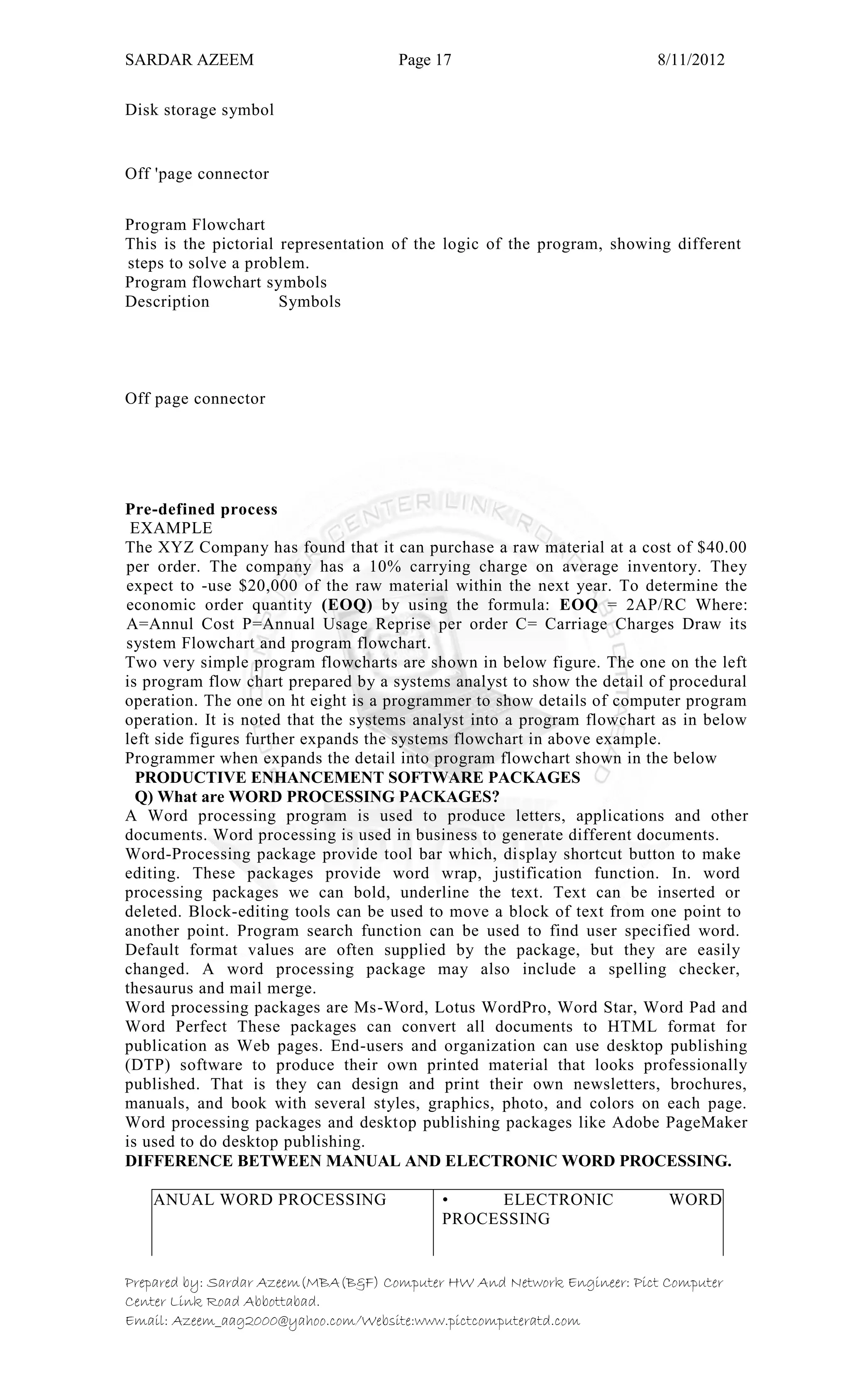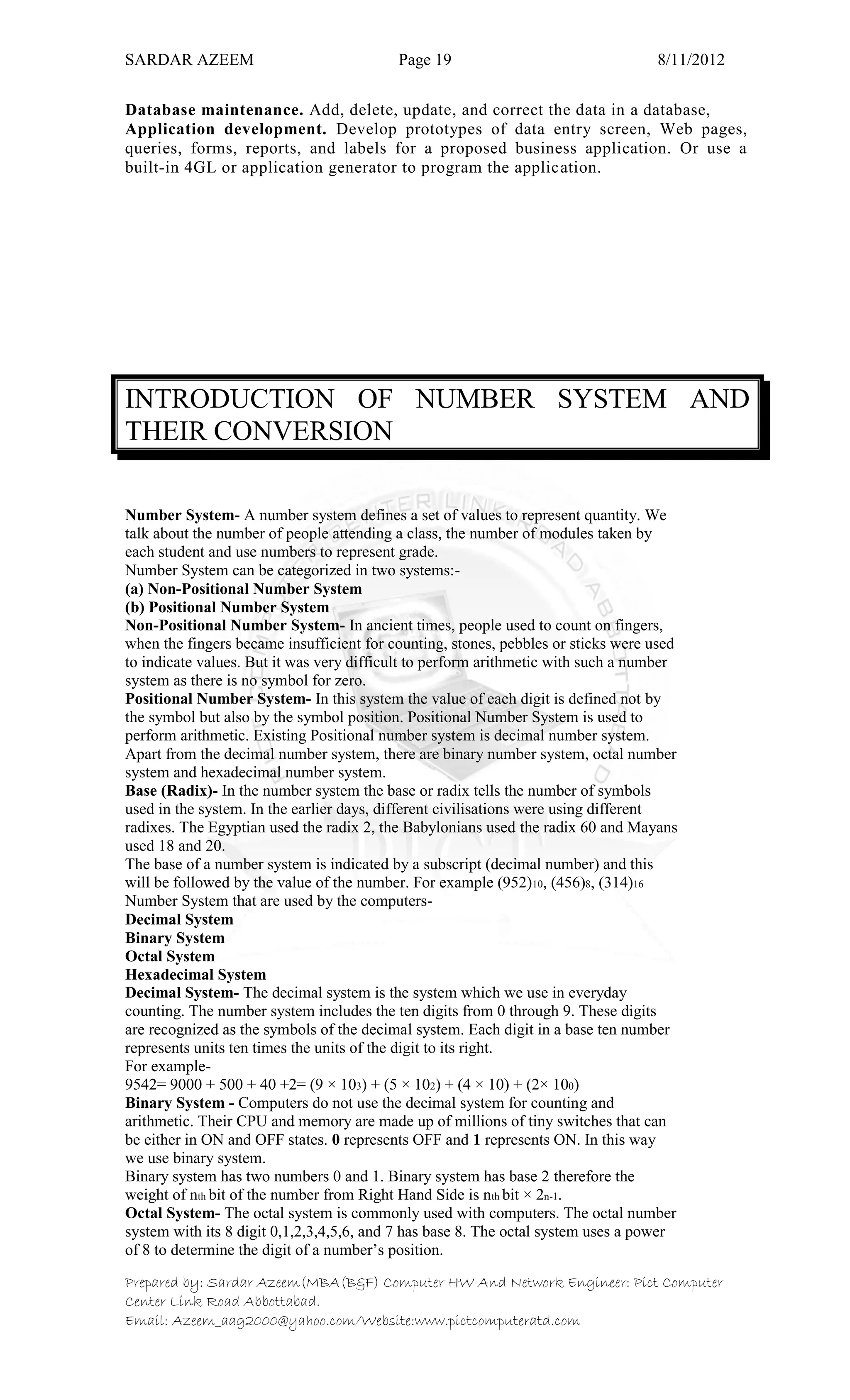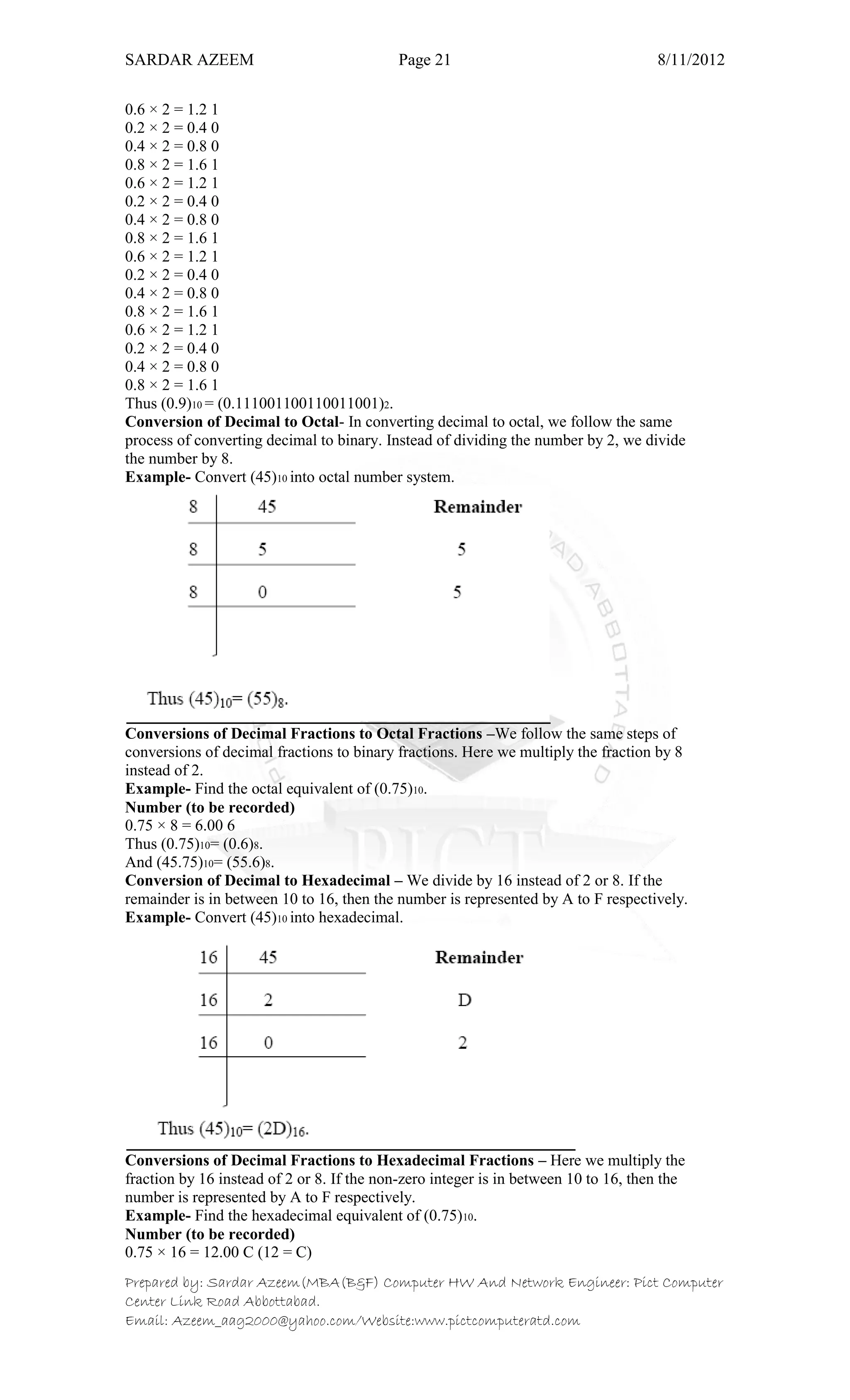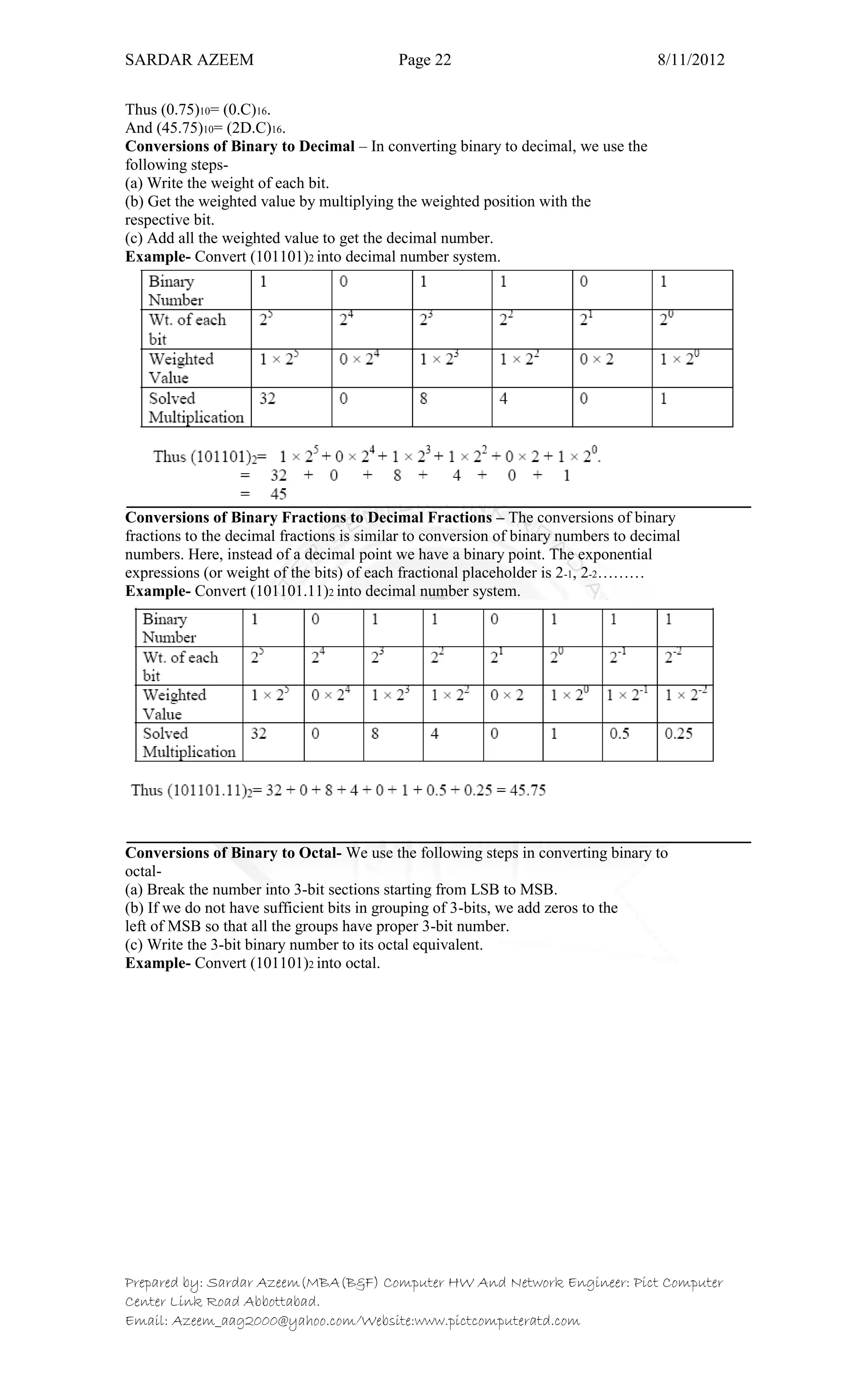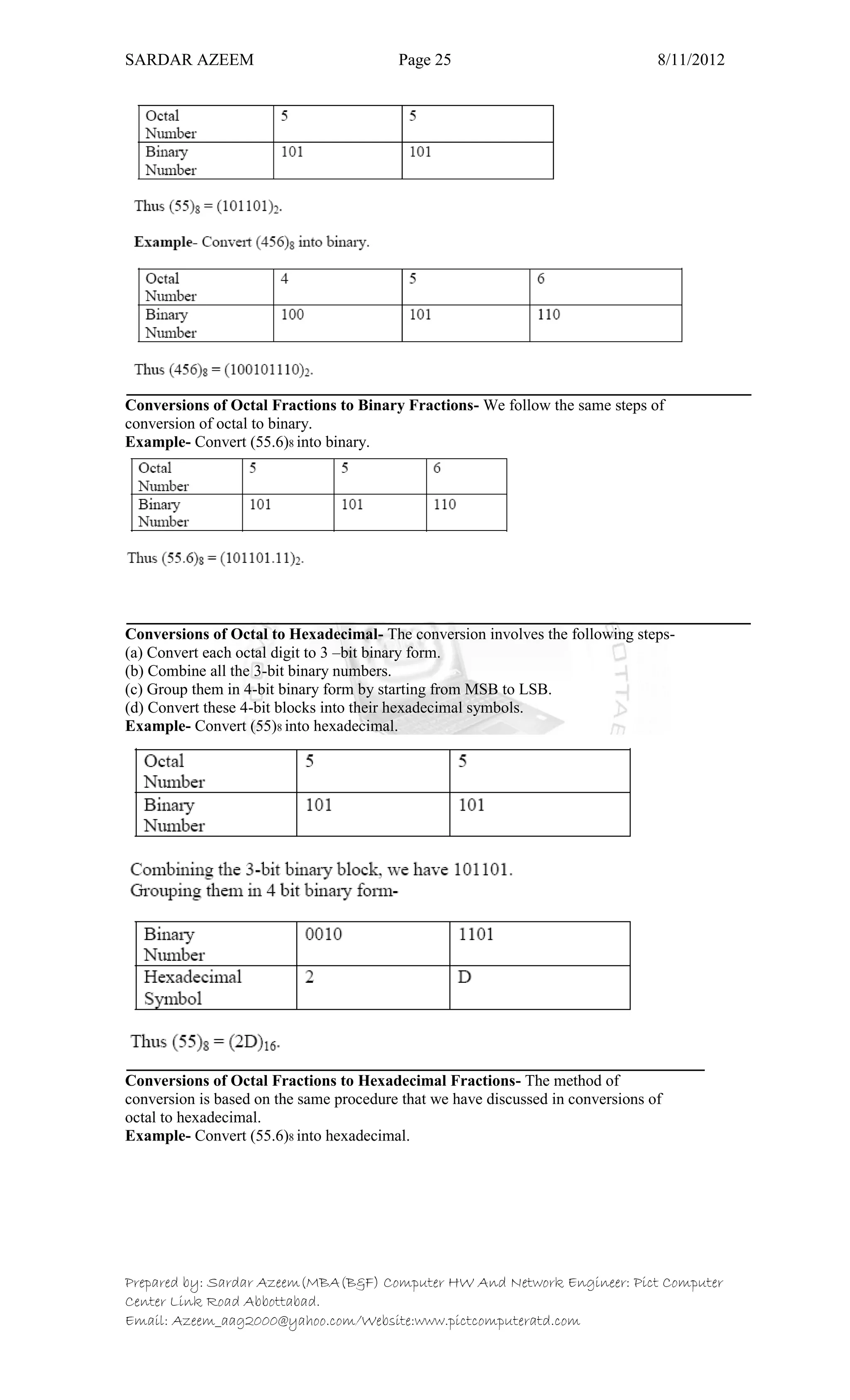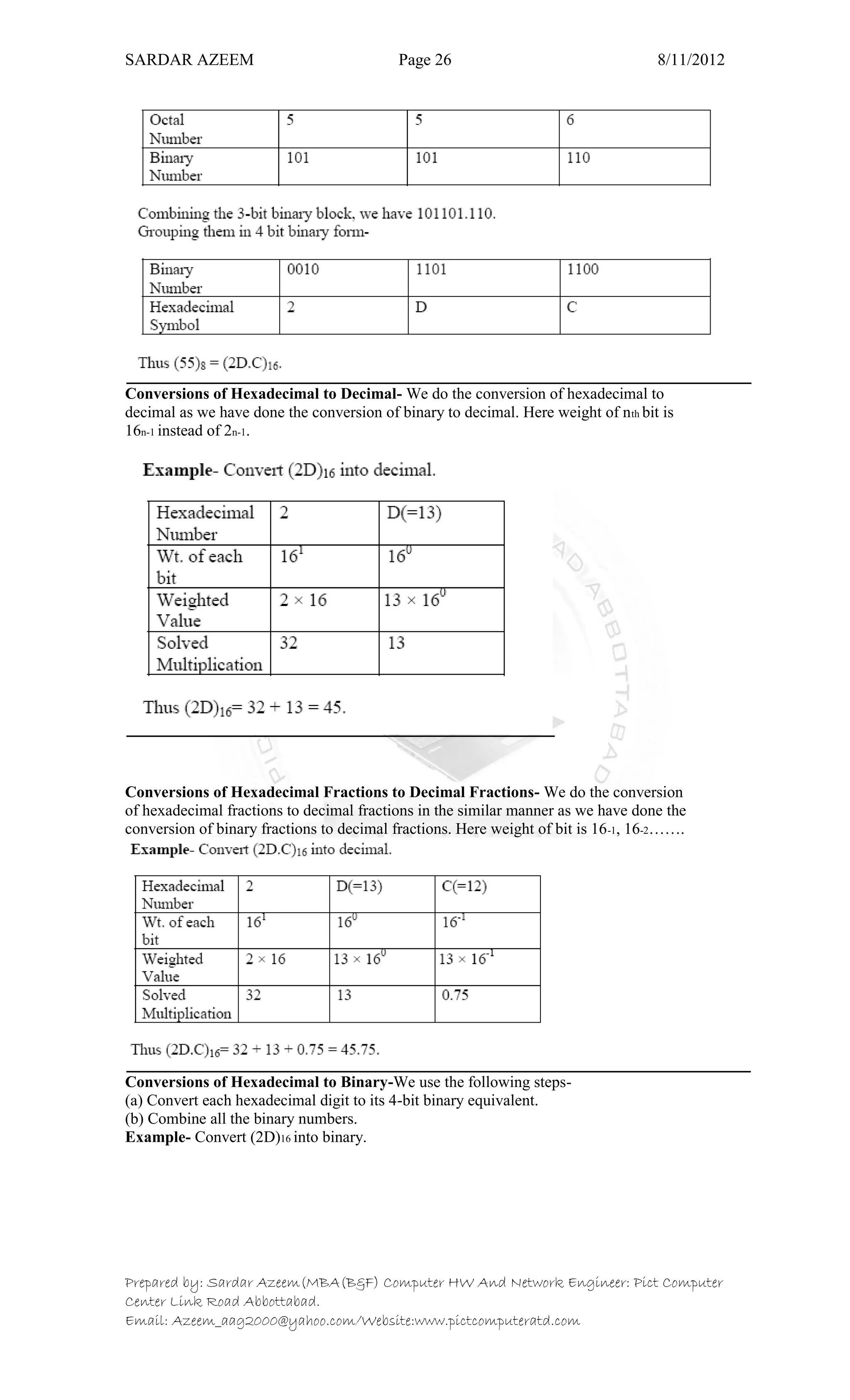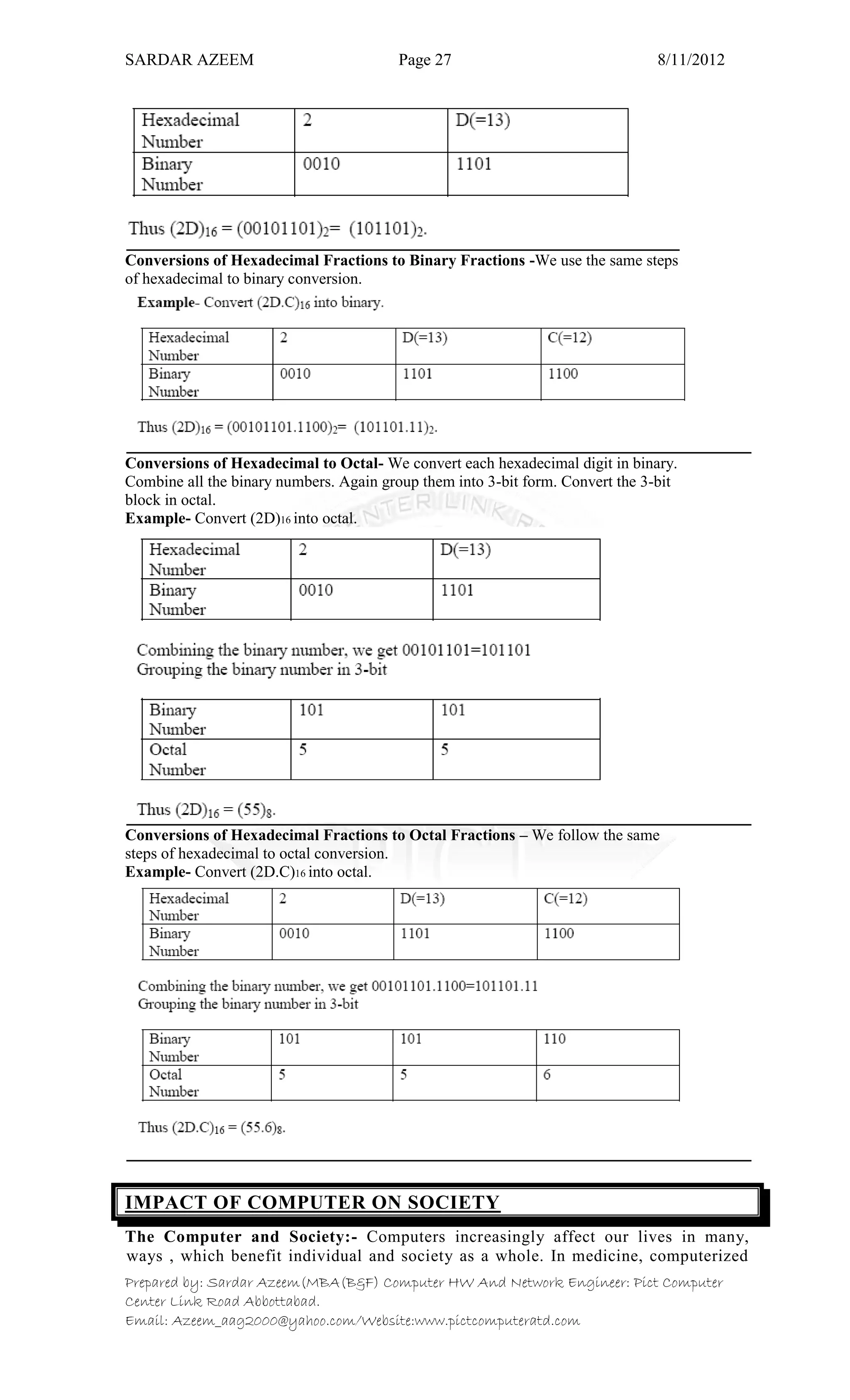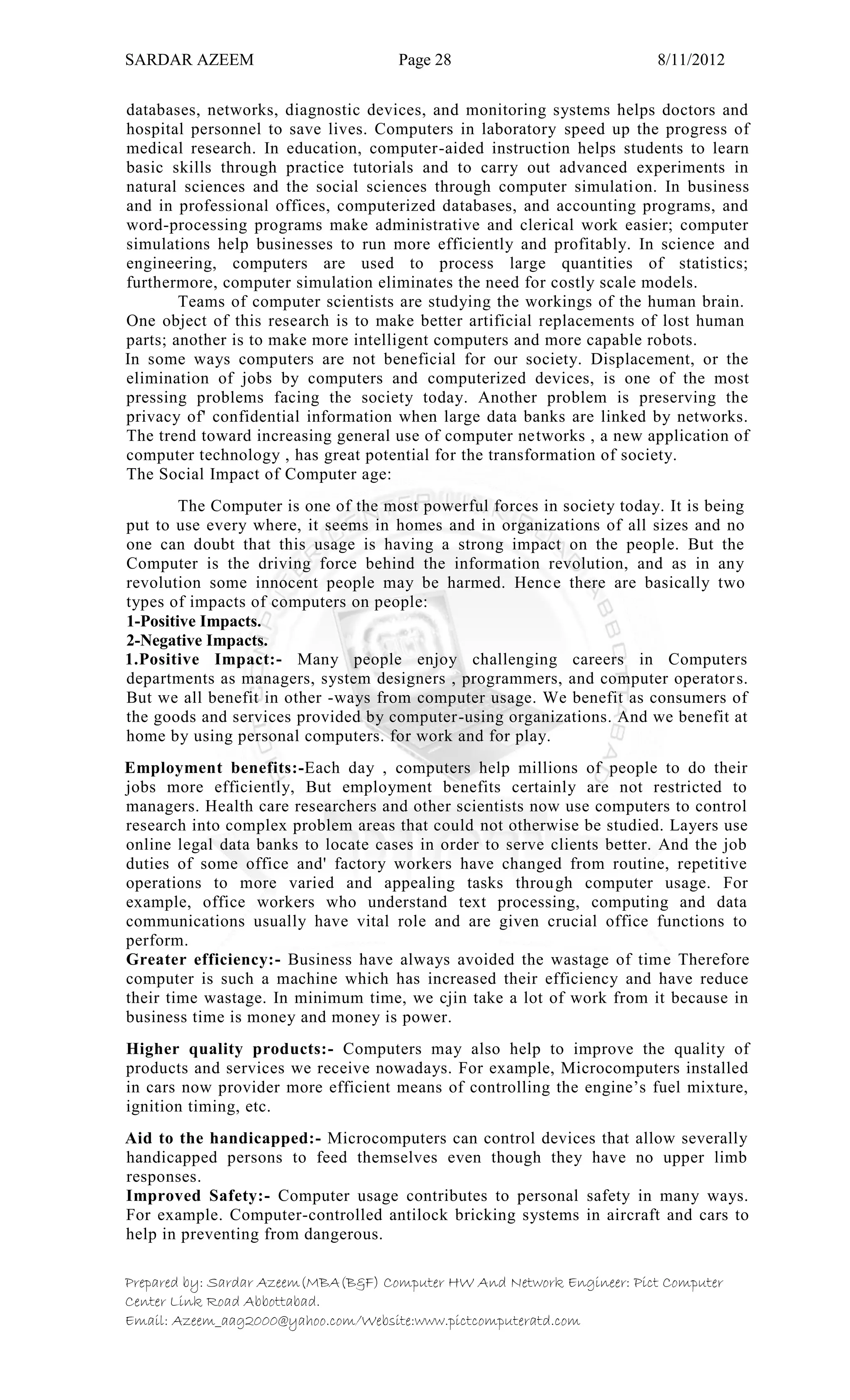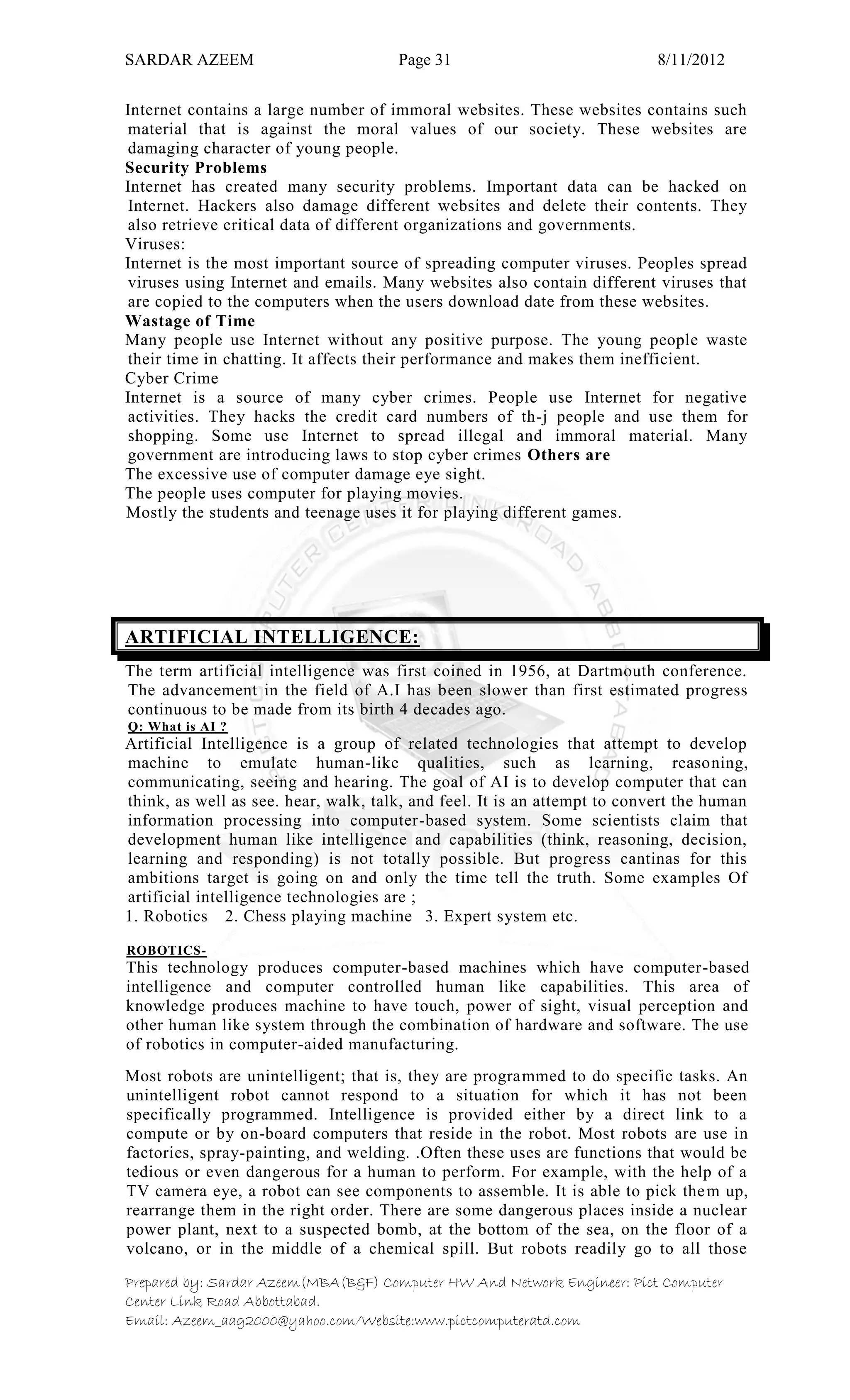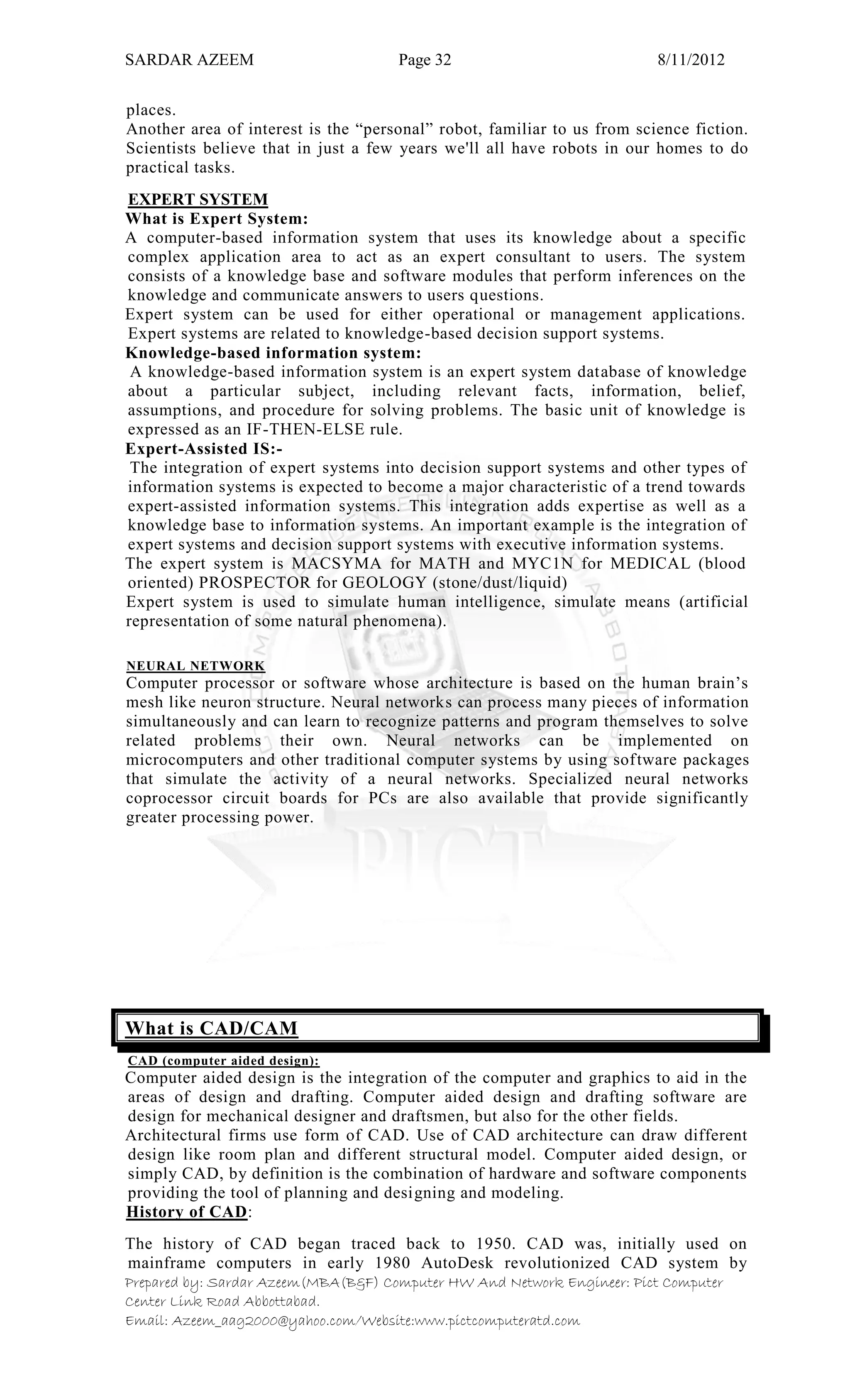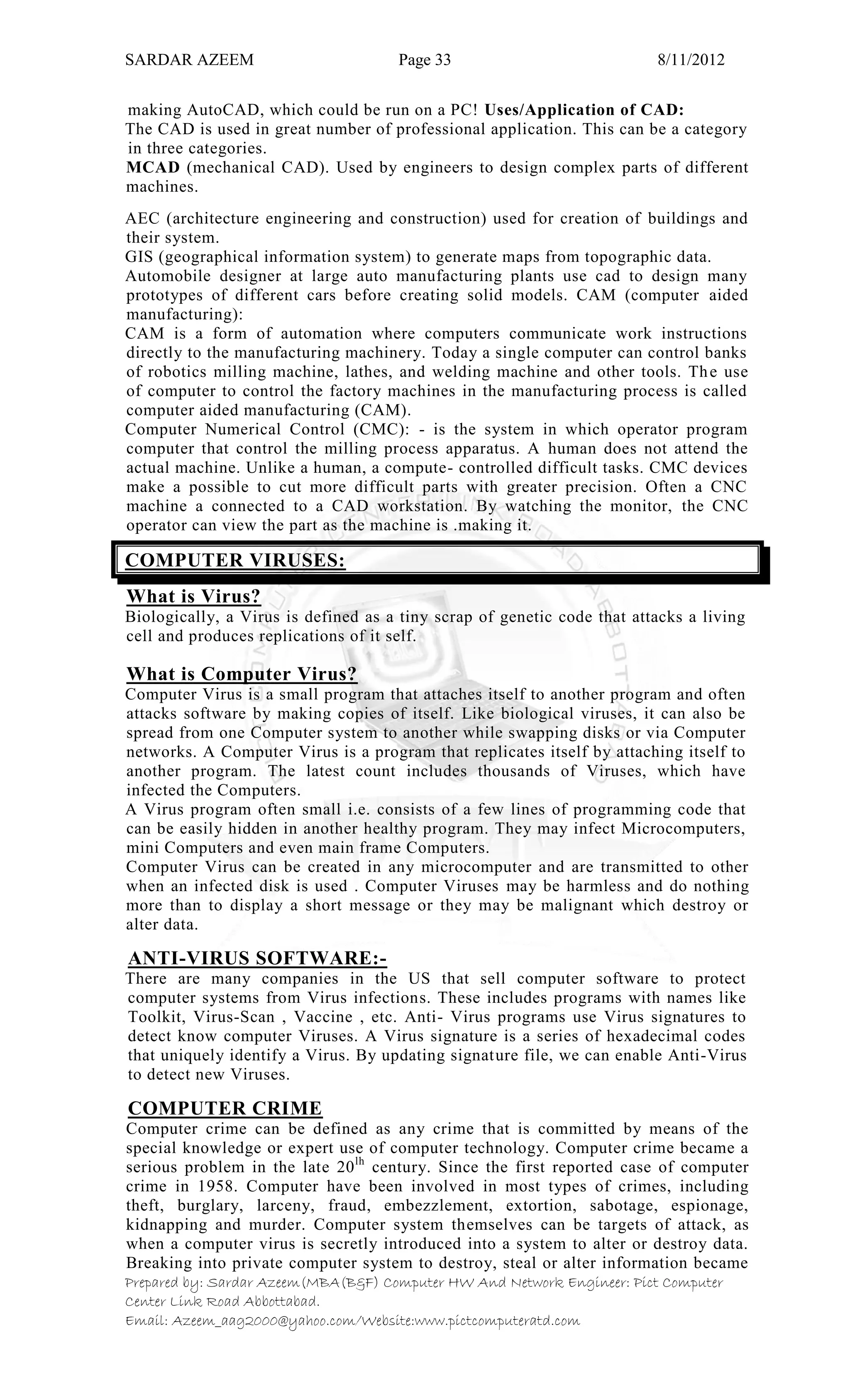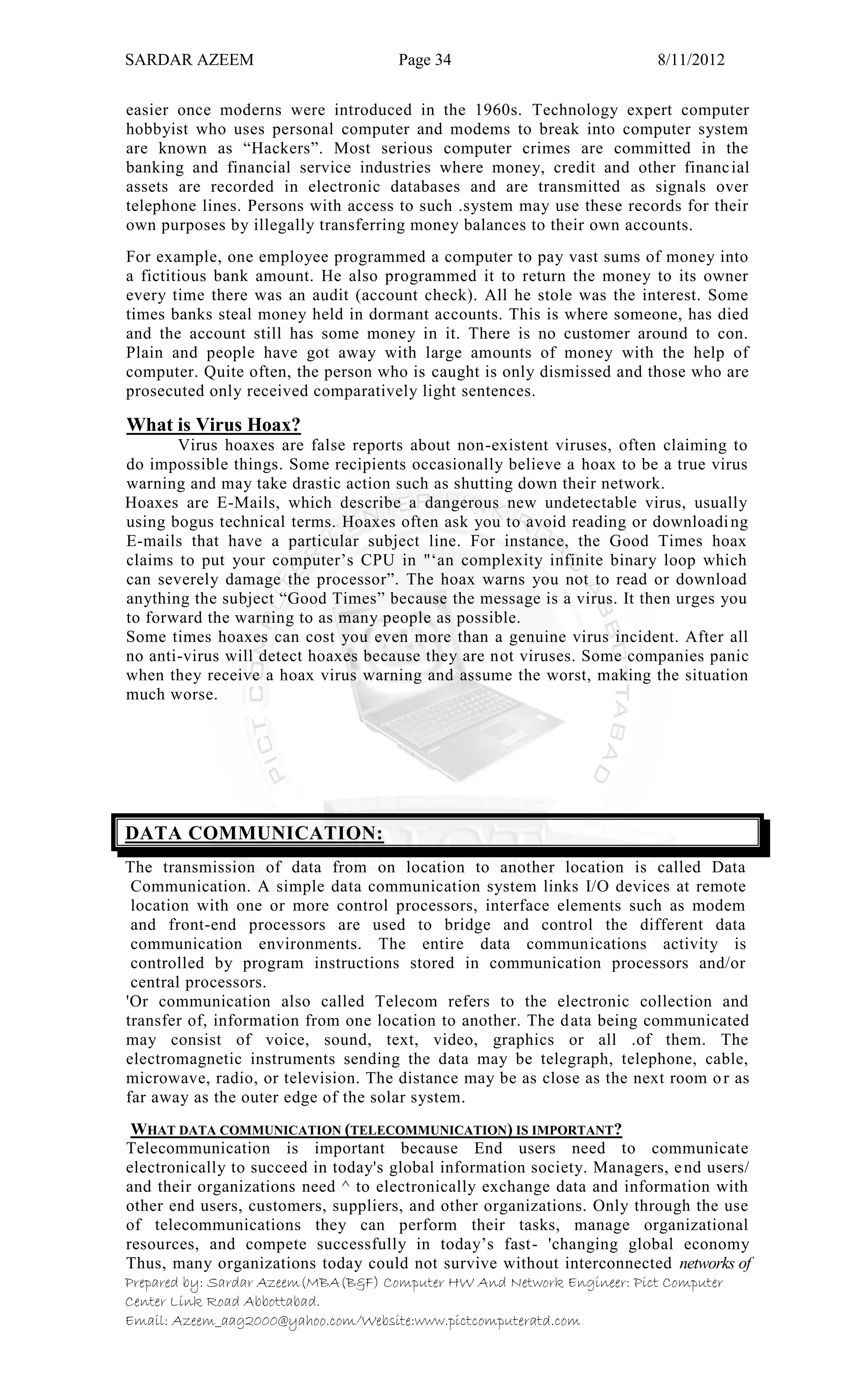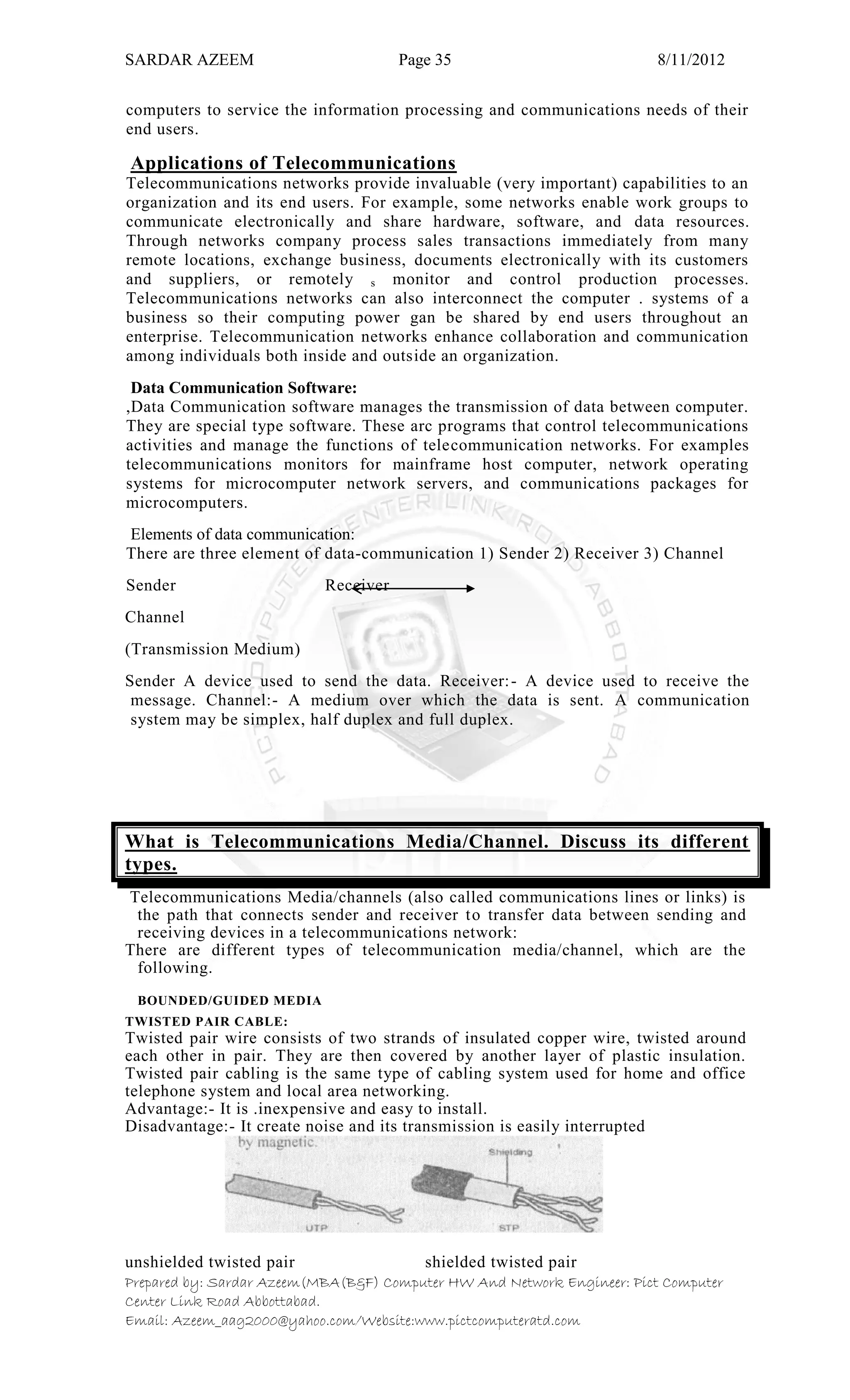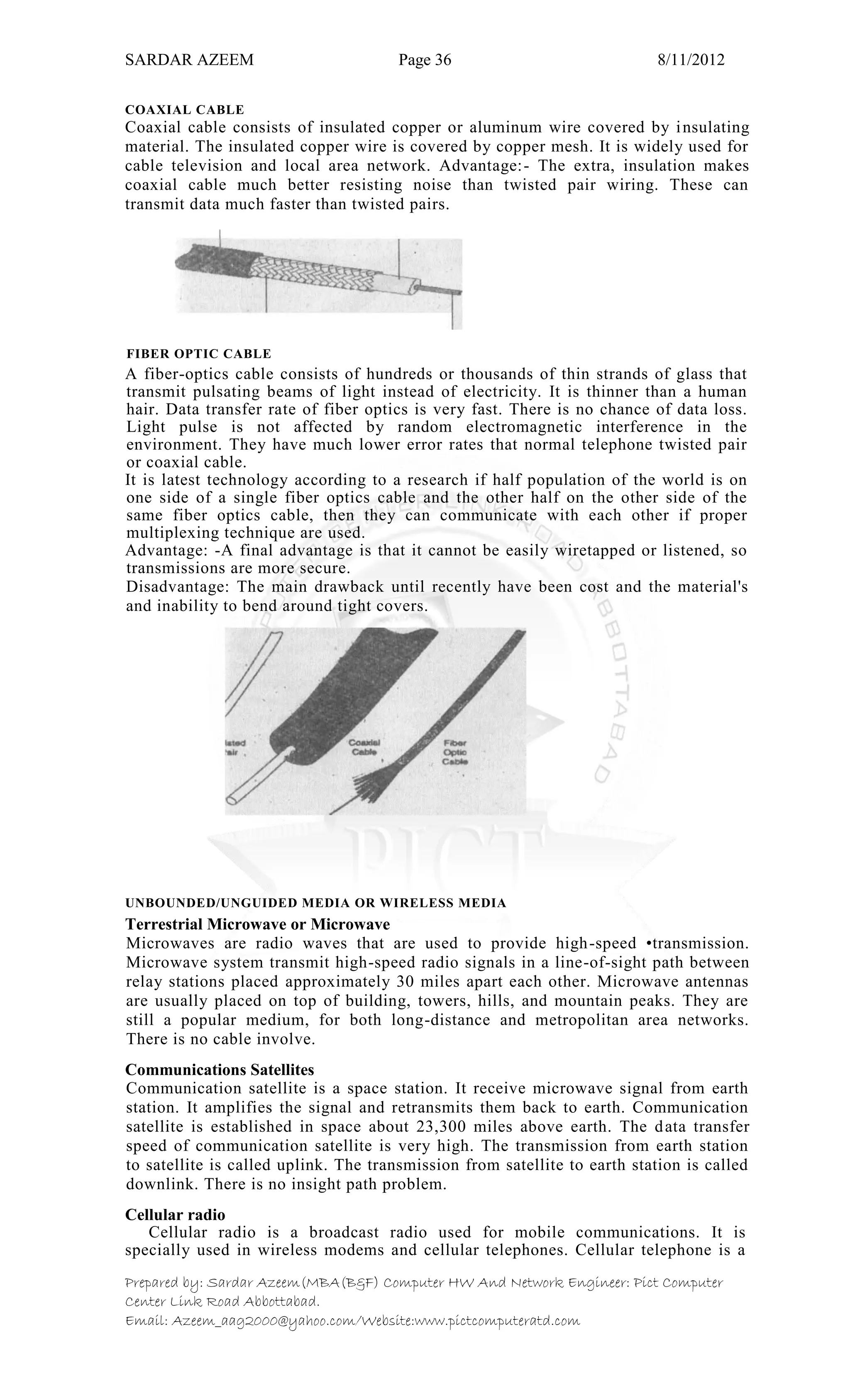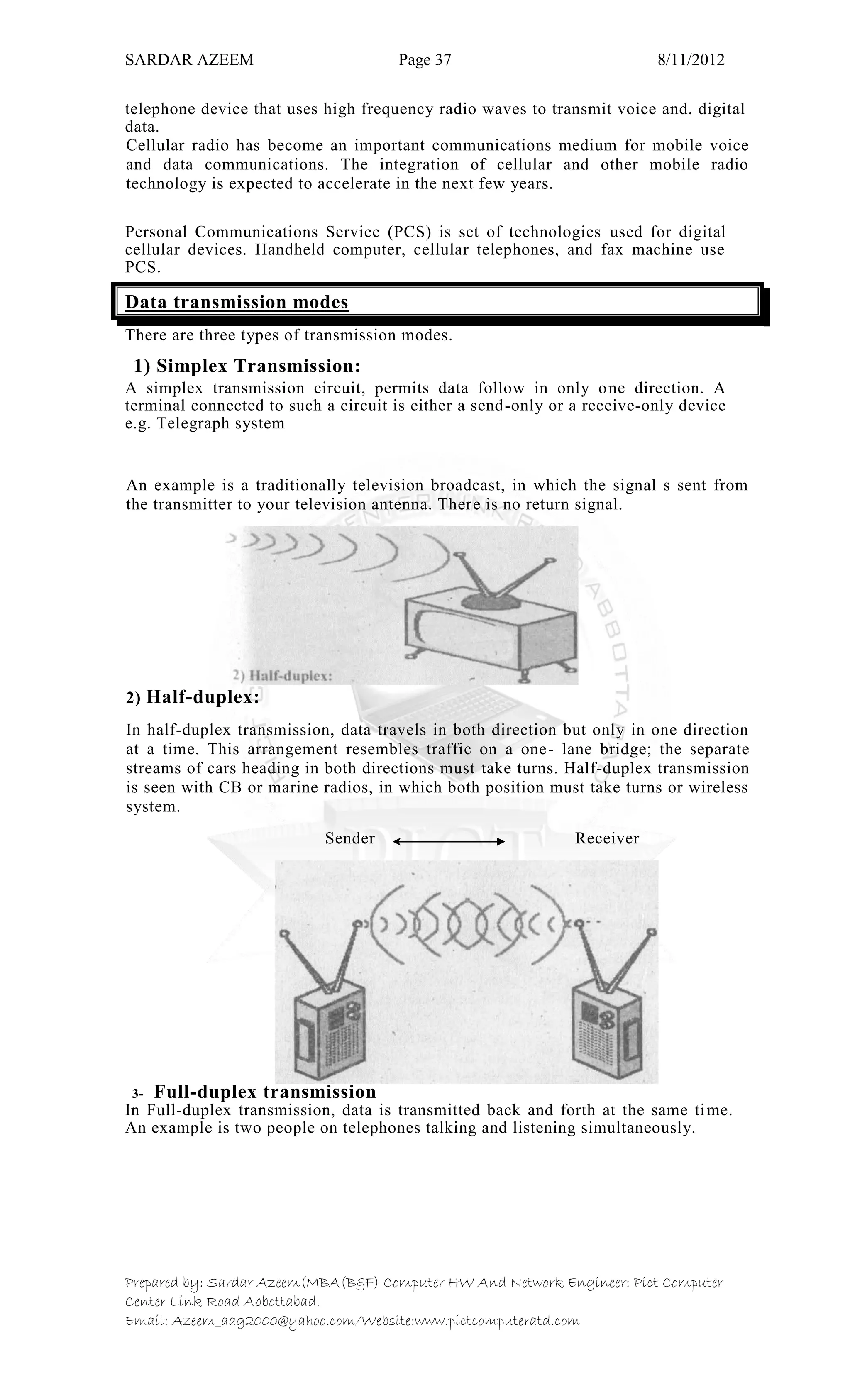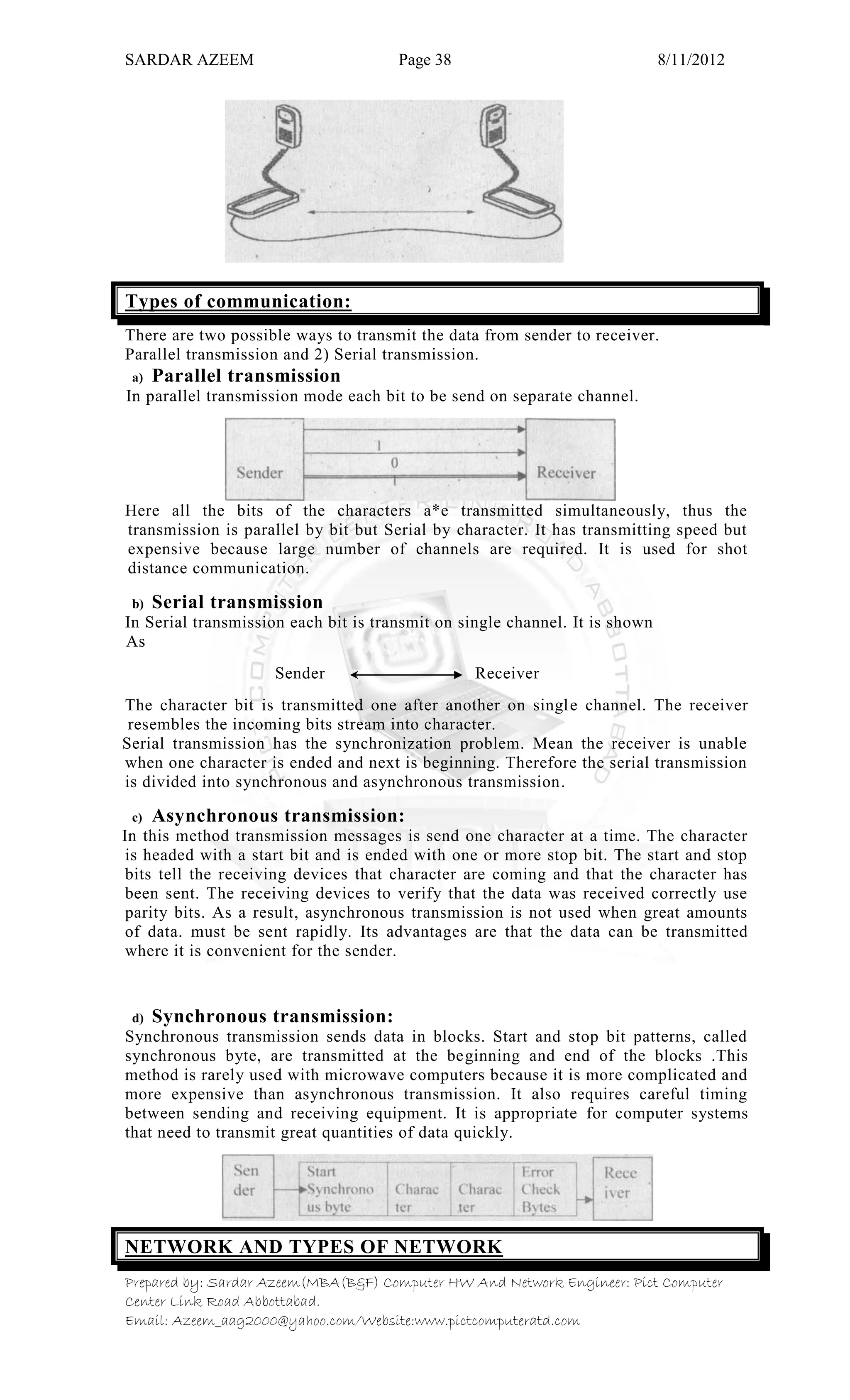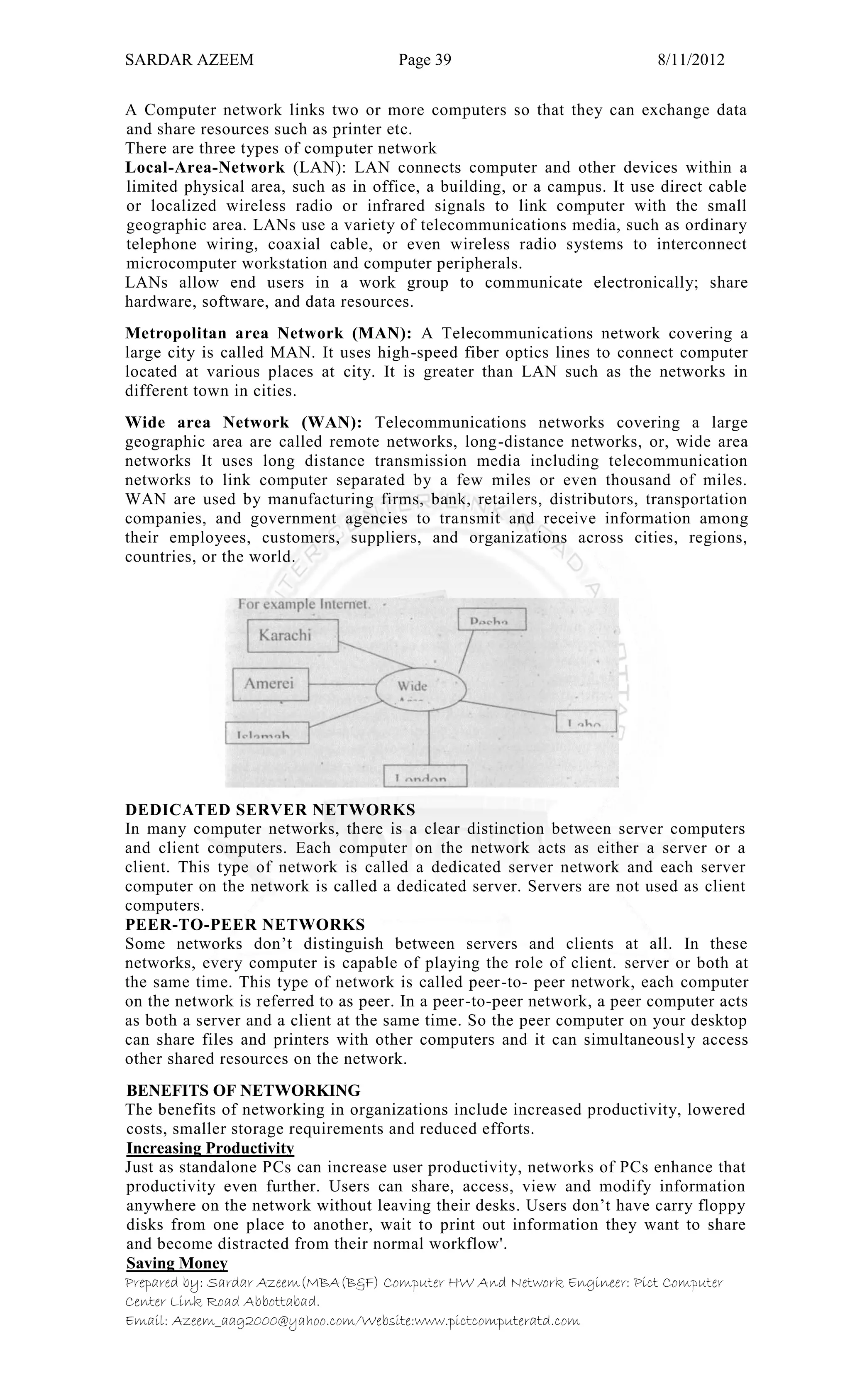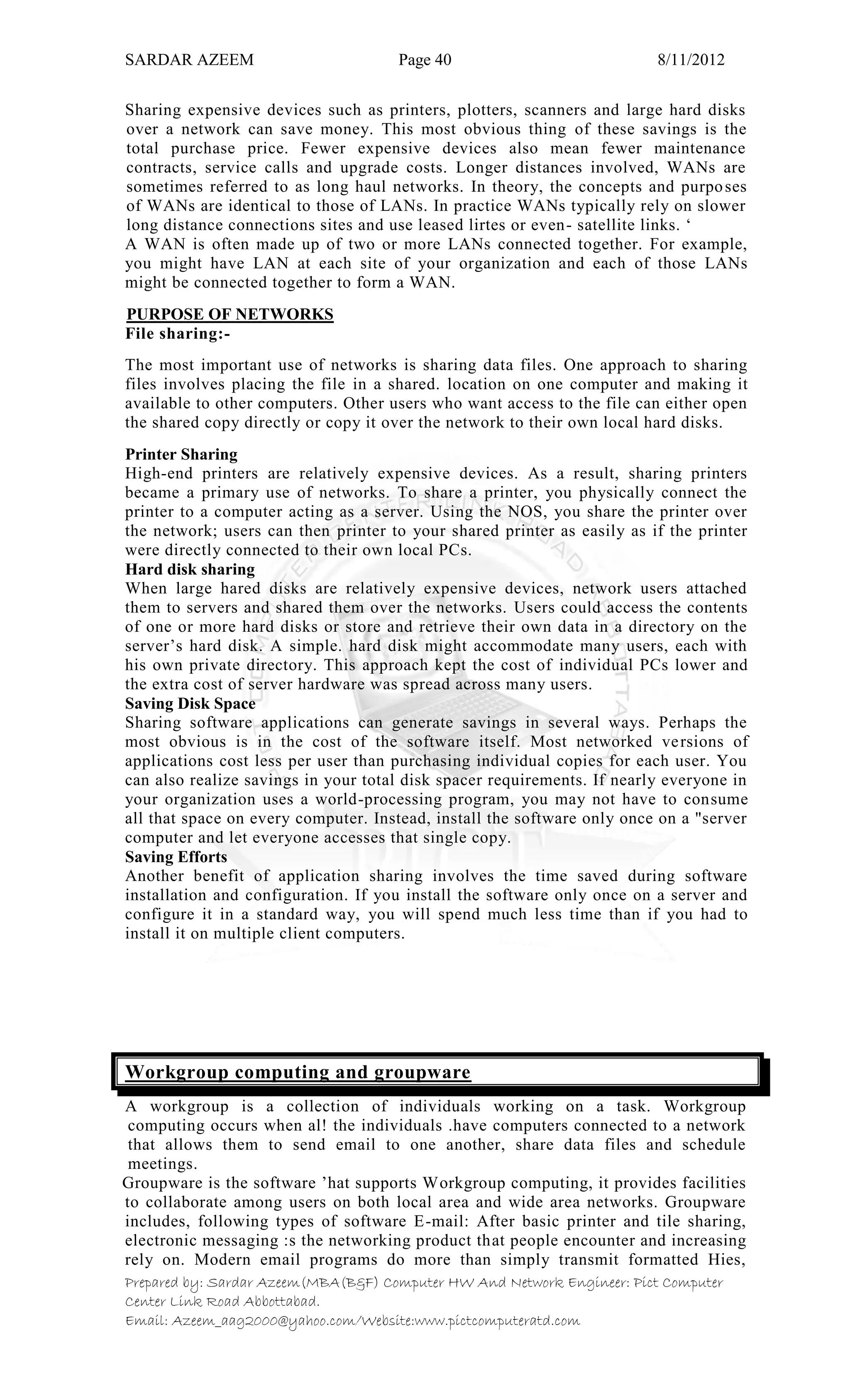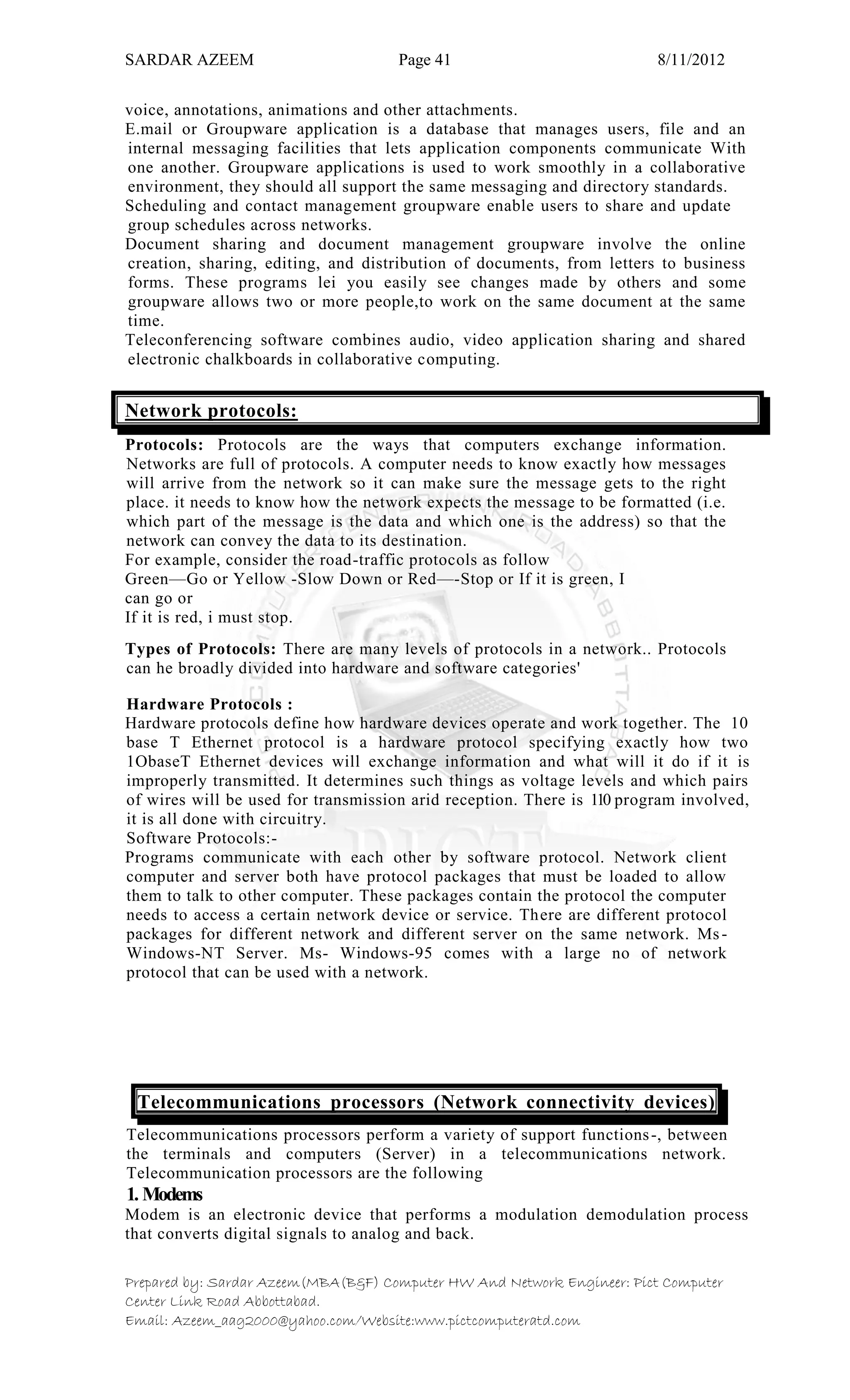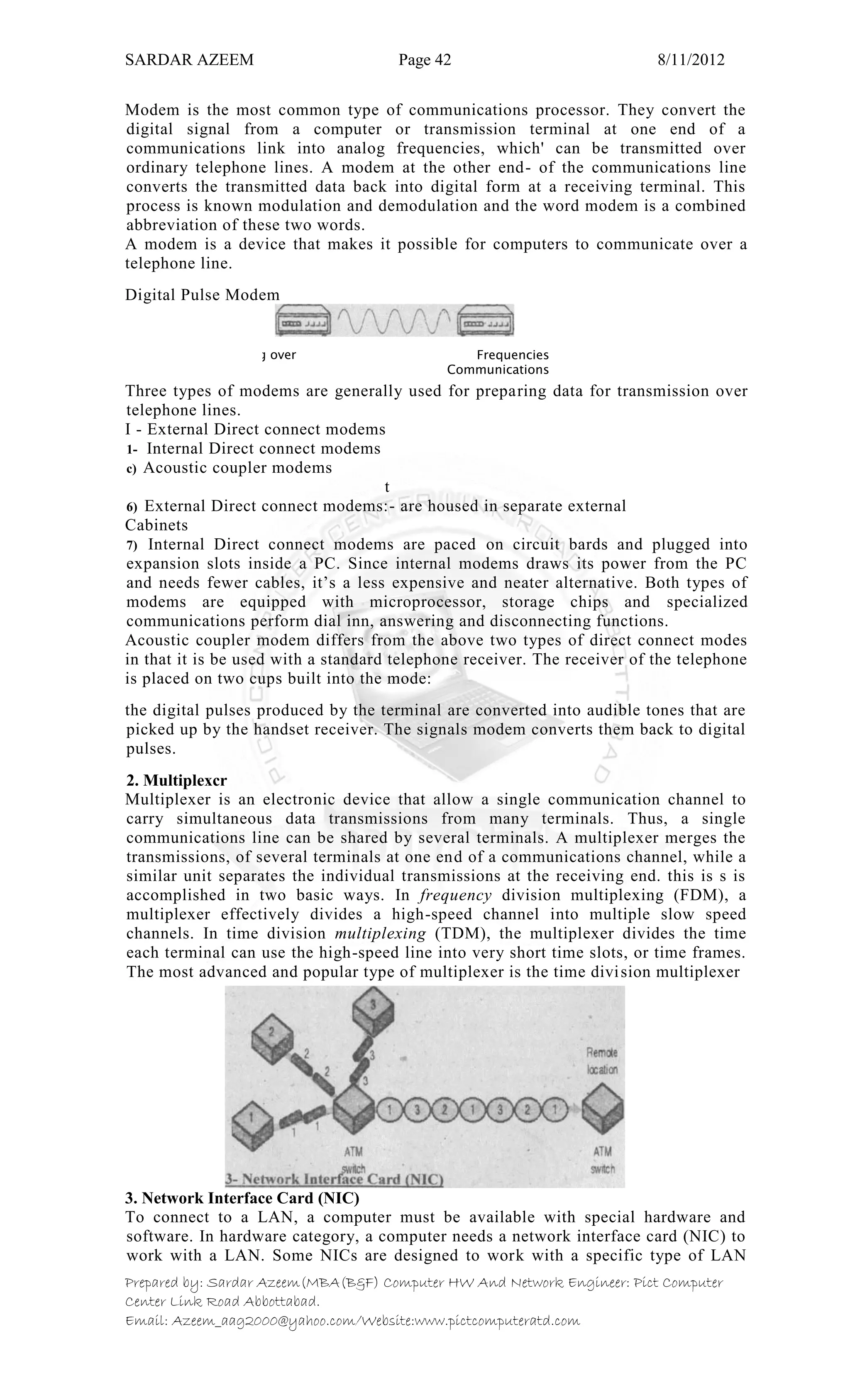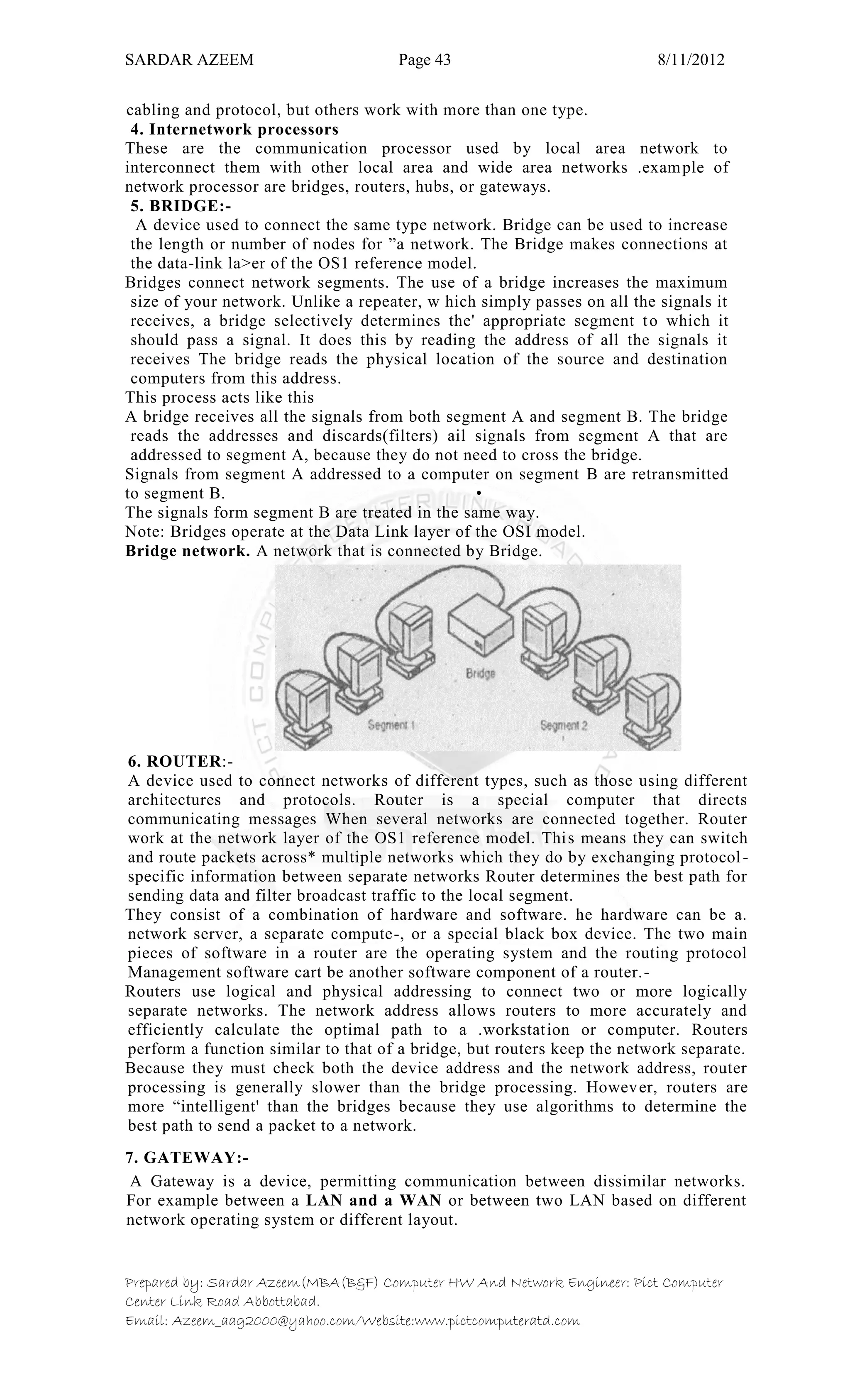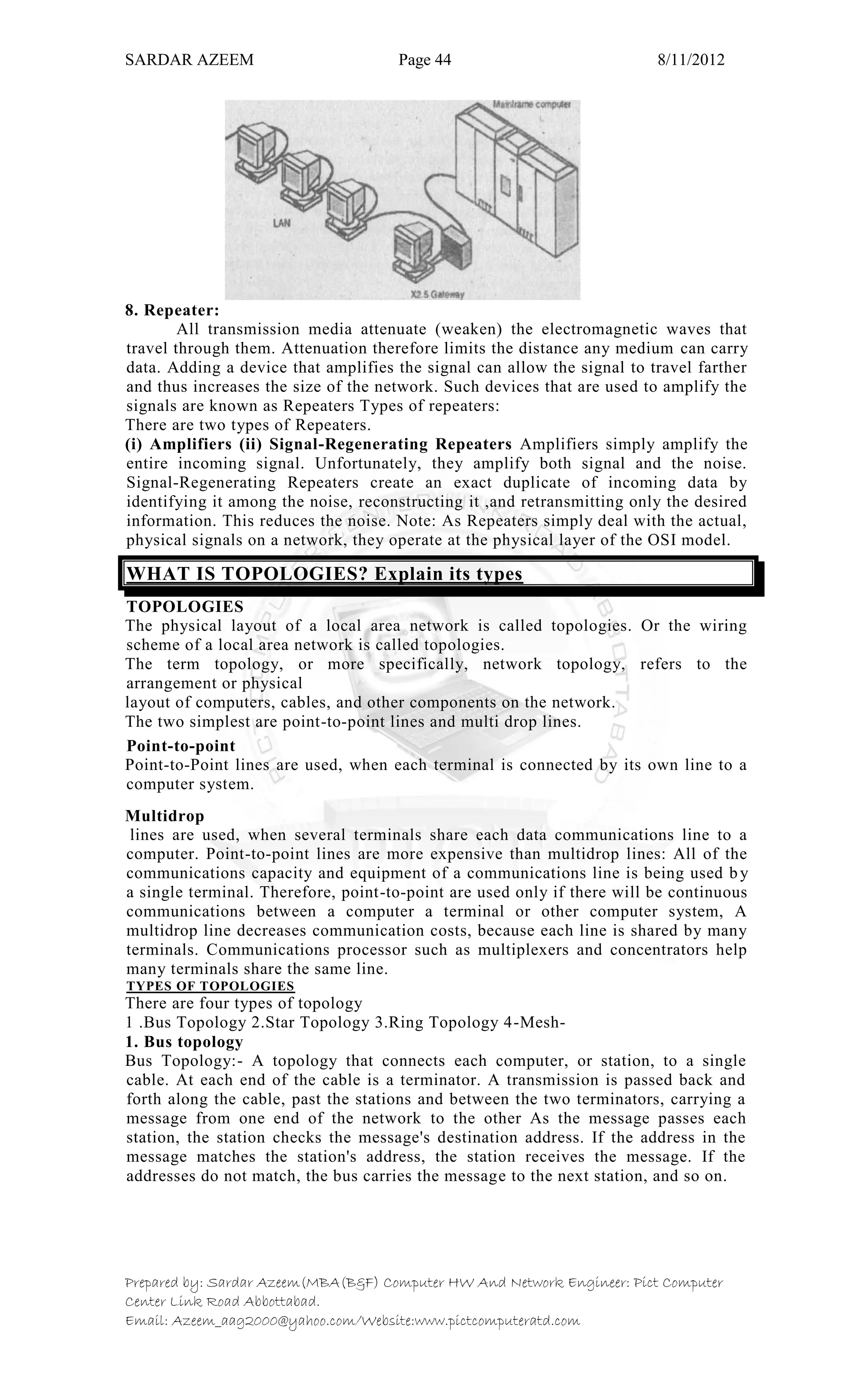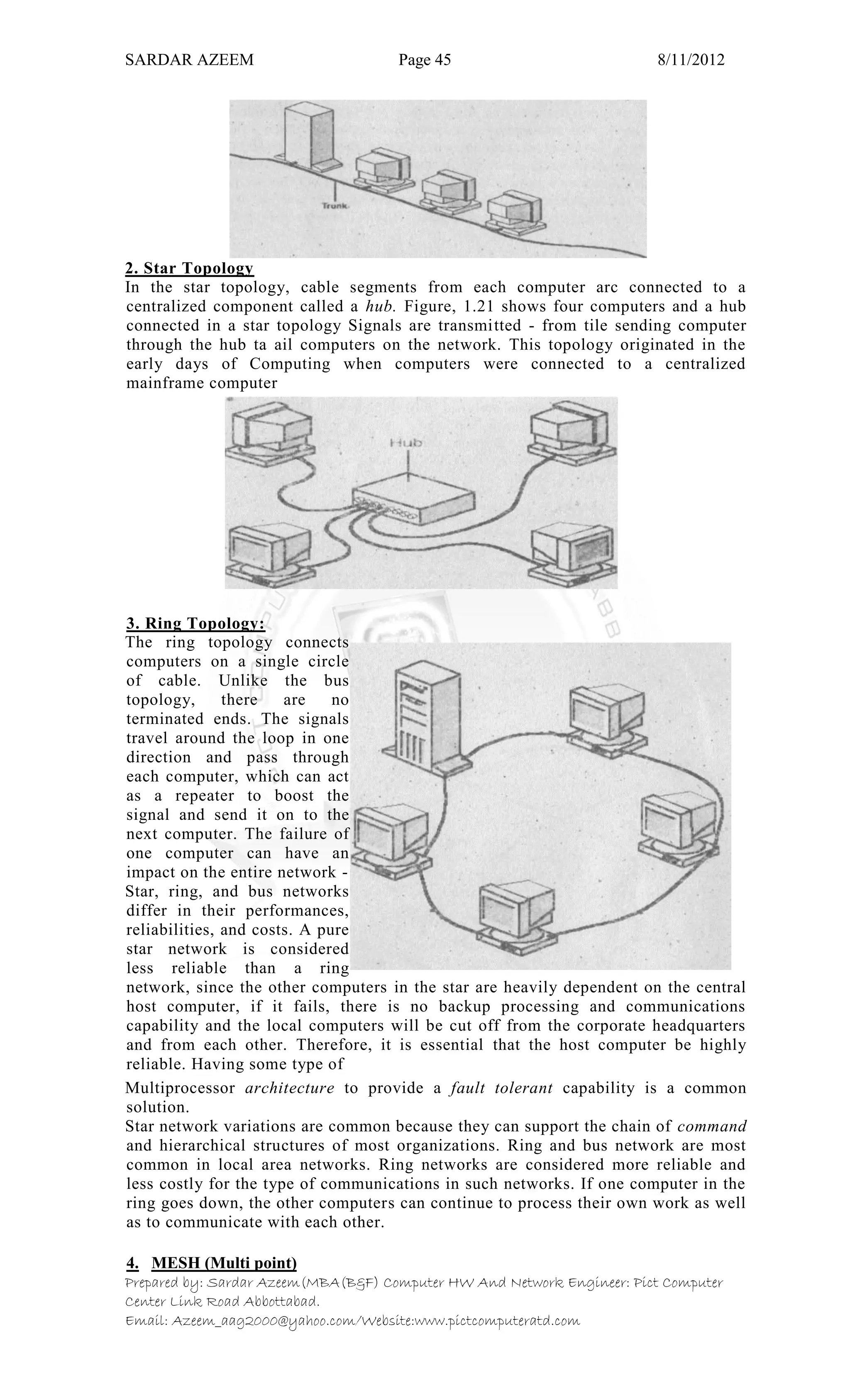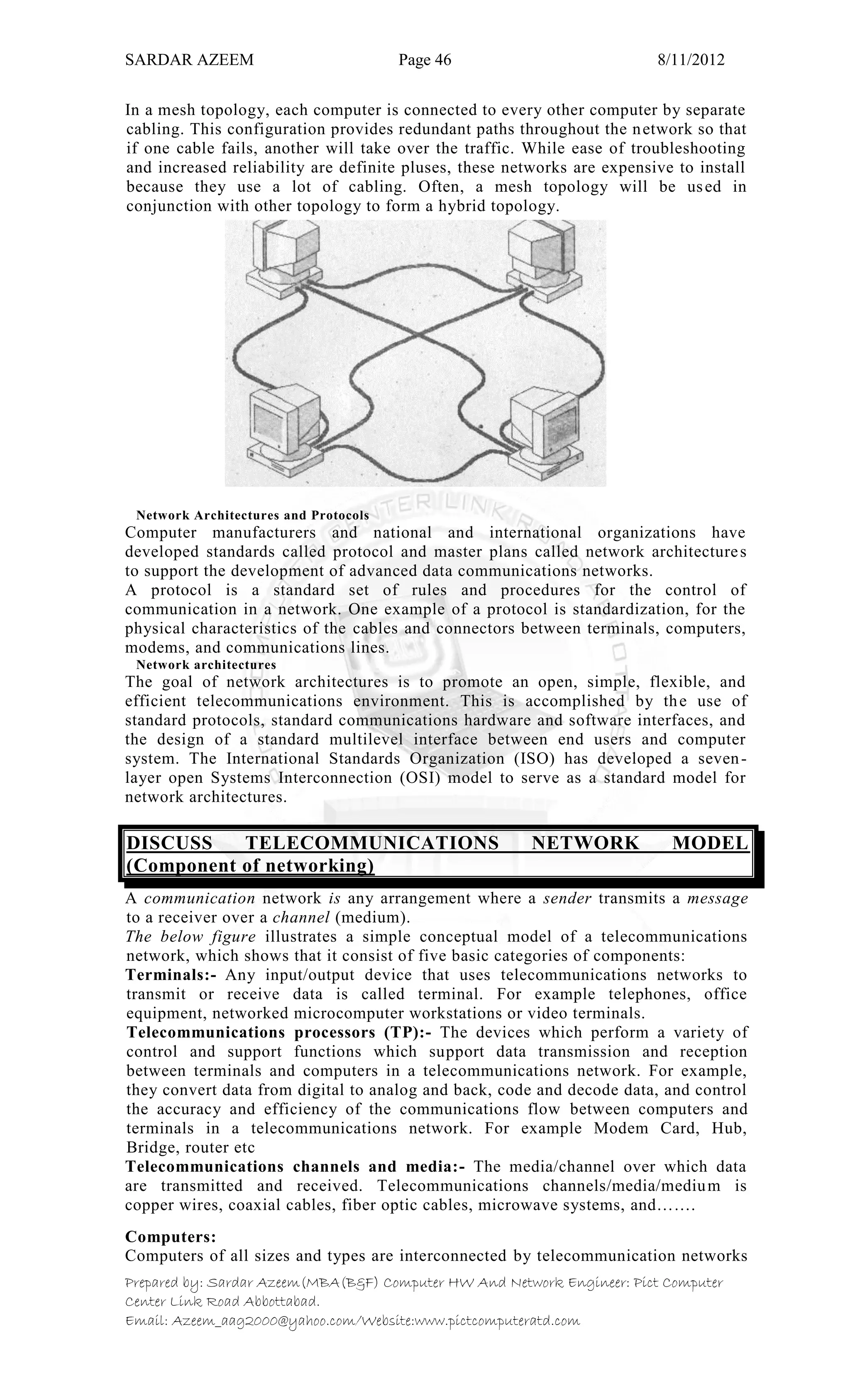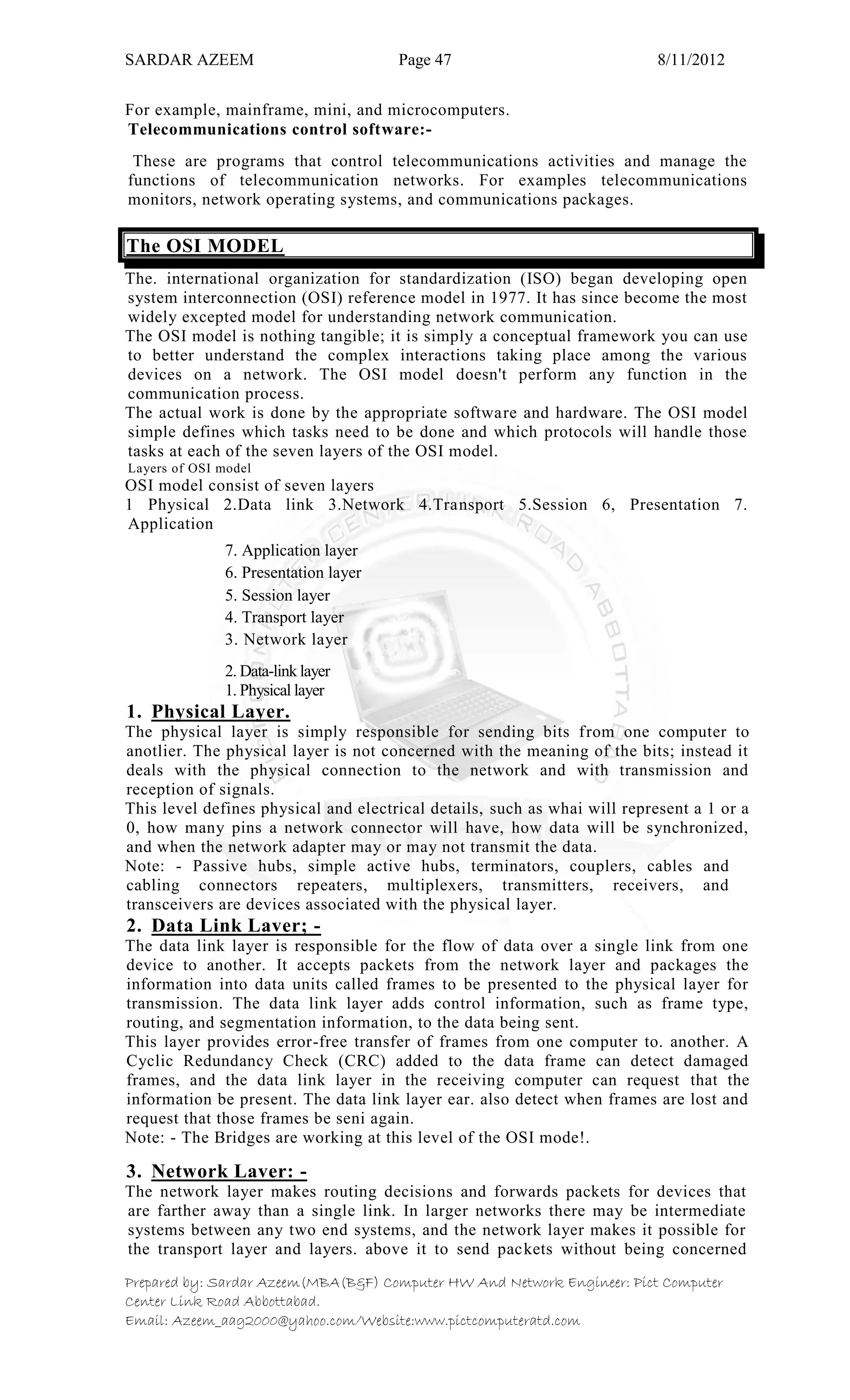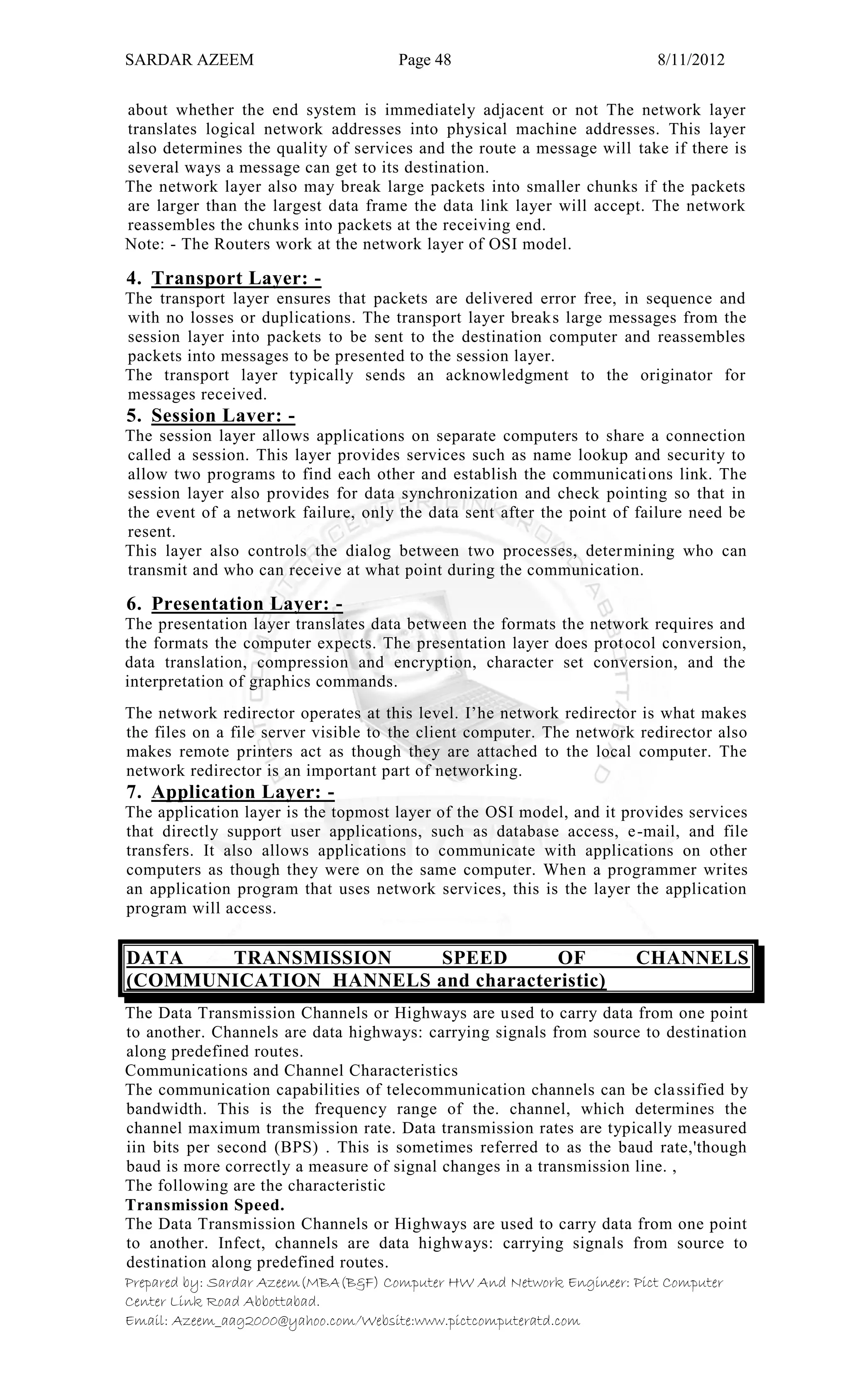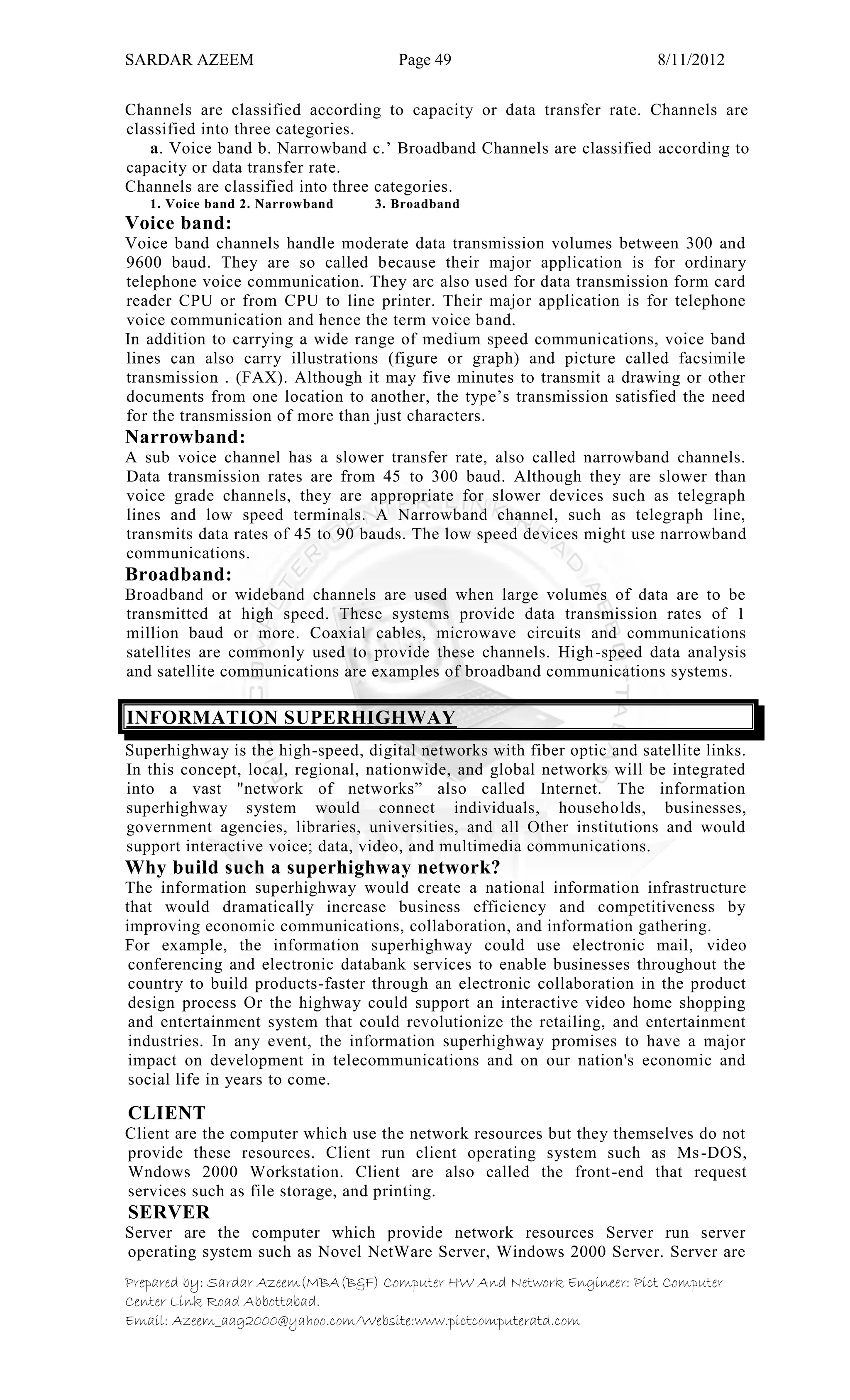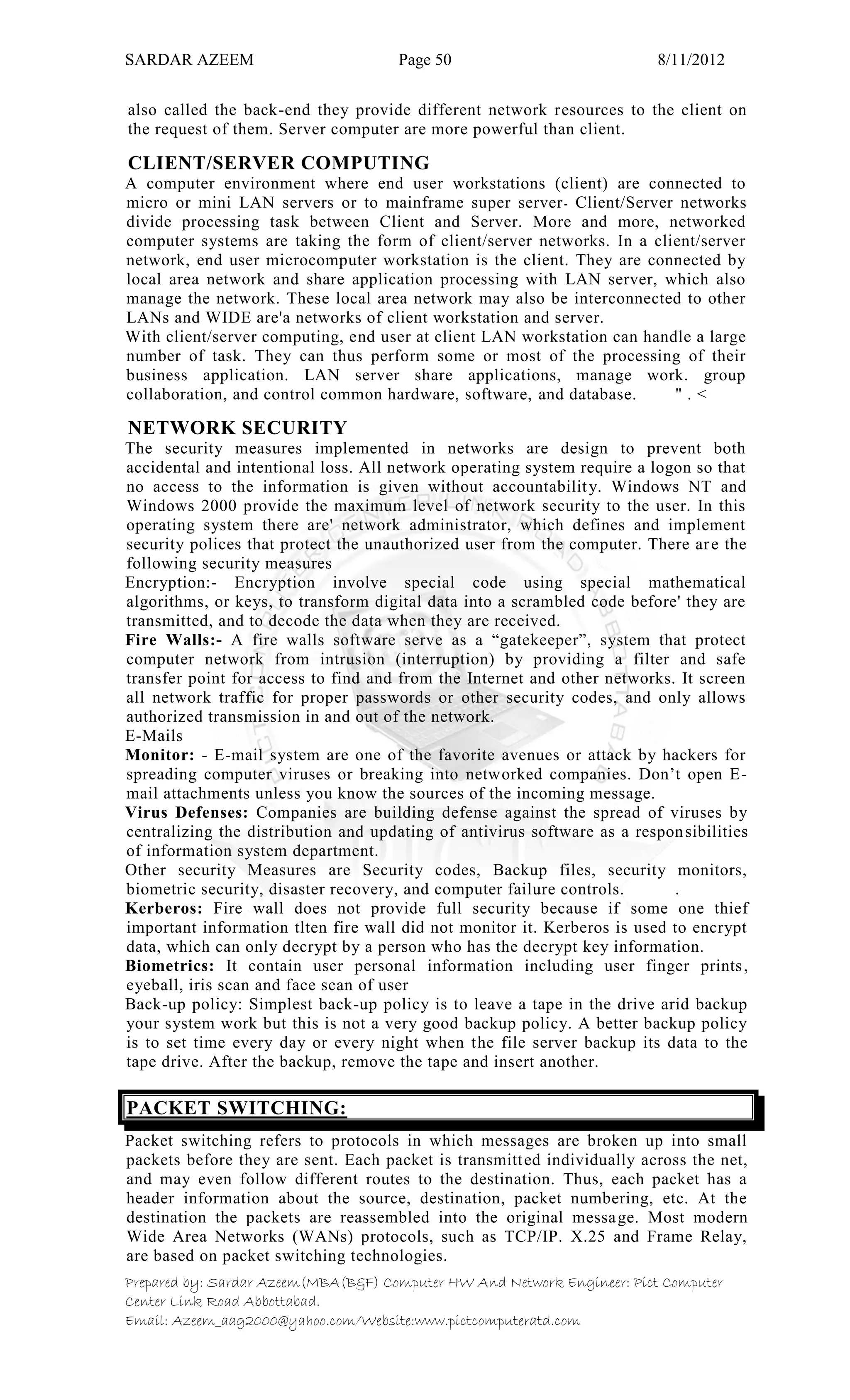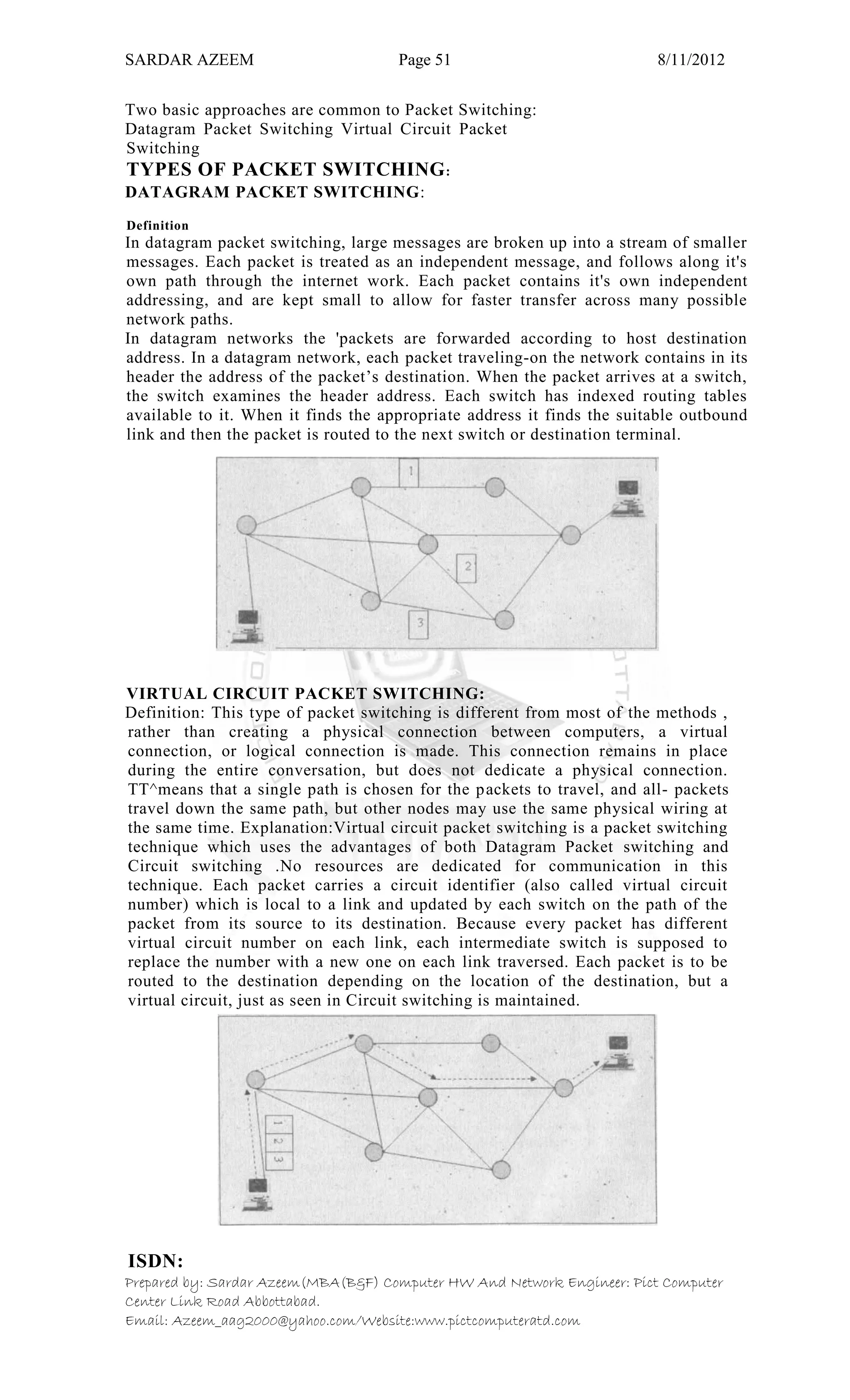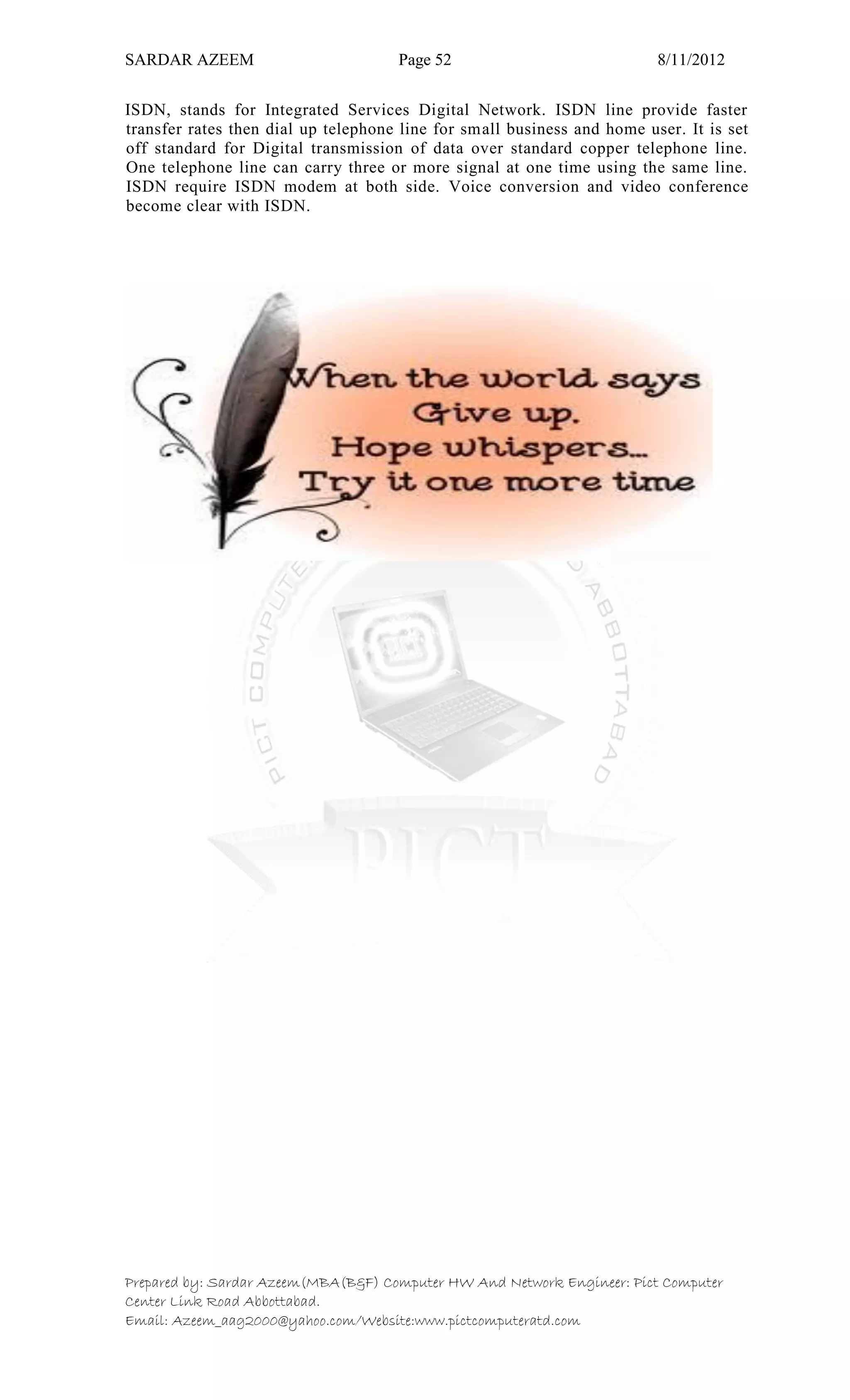This document defines information technology and its key components. It discusses how information technology combines computing and communication to spread information from one place to another via high-speed links. It identifies the six main elements of a computer and communication system: people, procedures, data/information, hardware, software, and communication. It also defines data and information, and distinguishes between the two. Finally, it discusses different types of data processing systems including manual/conventional and electronic data processing systems.
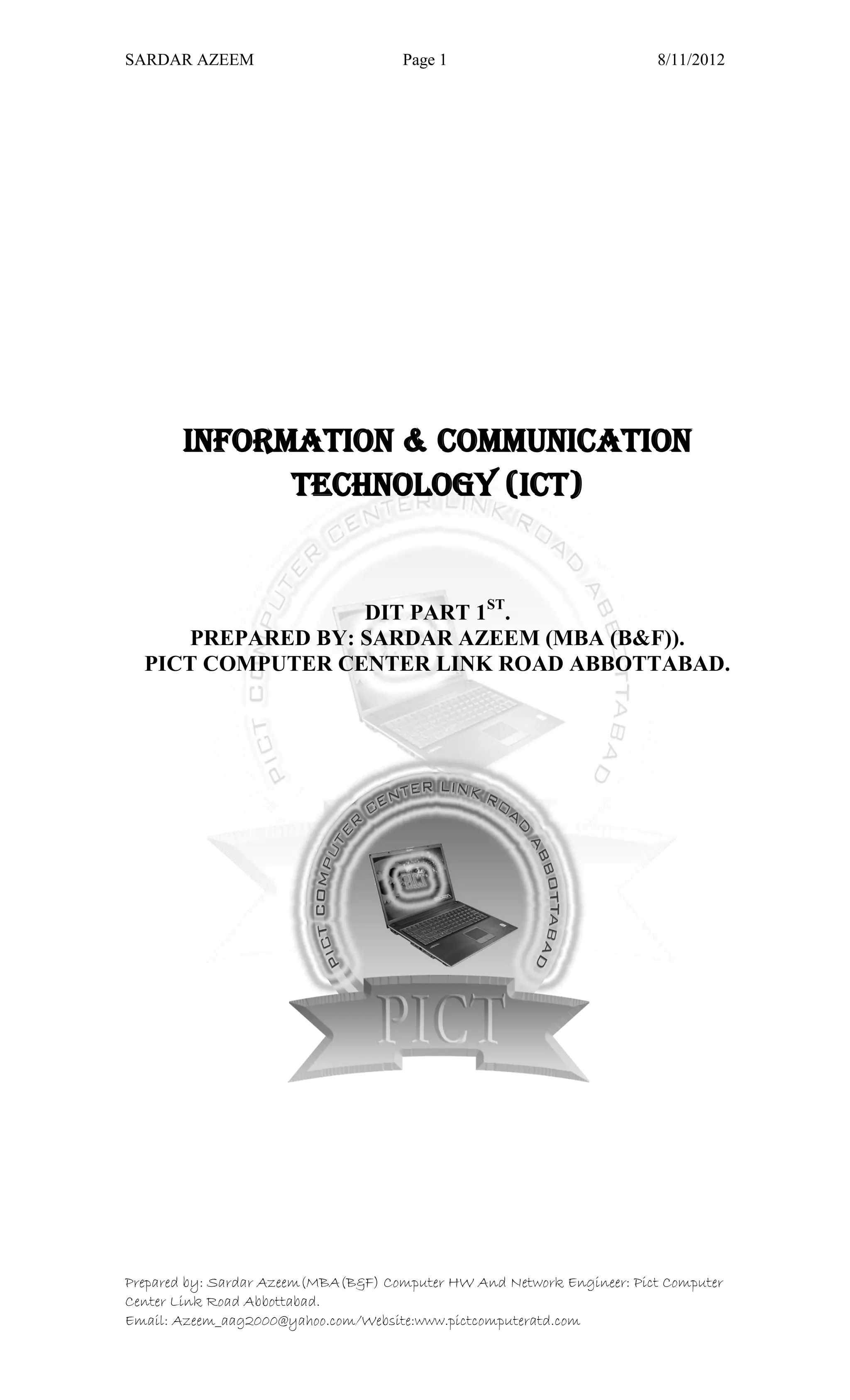
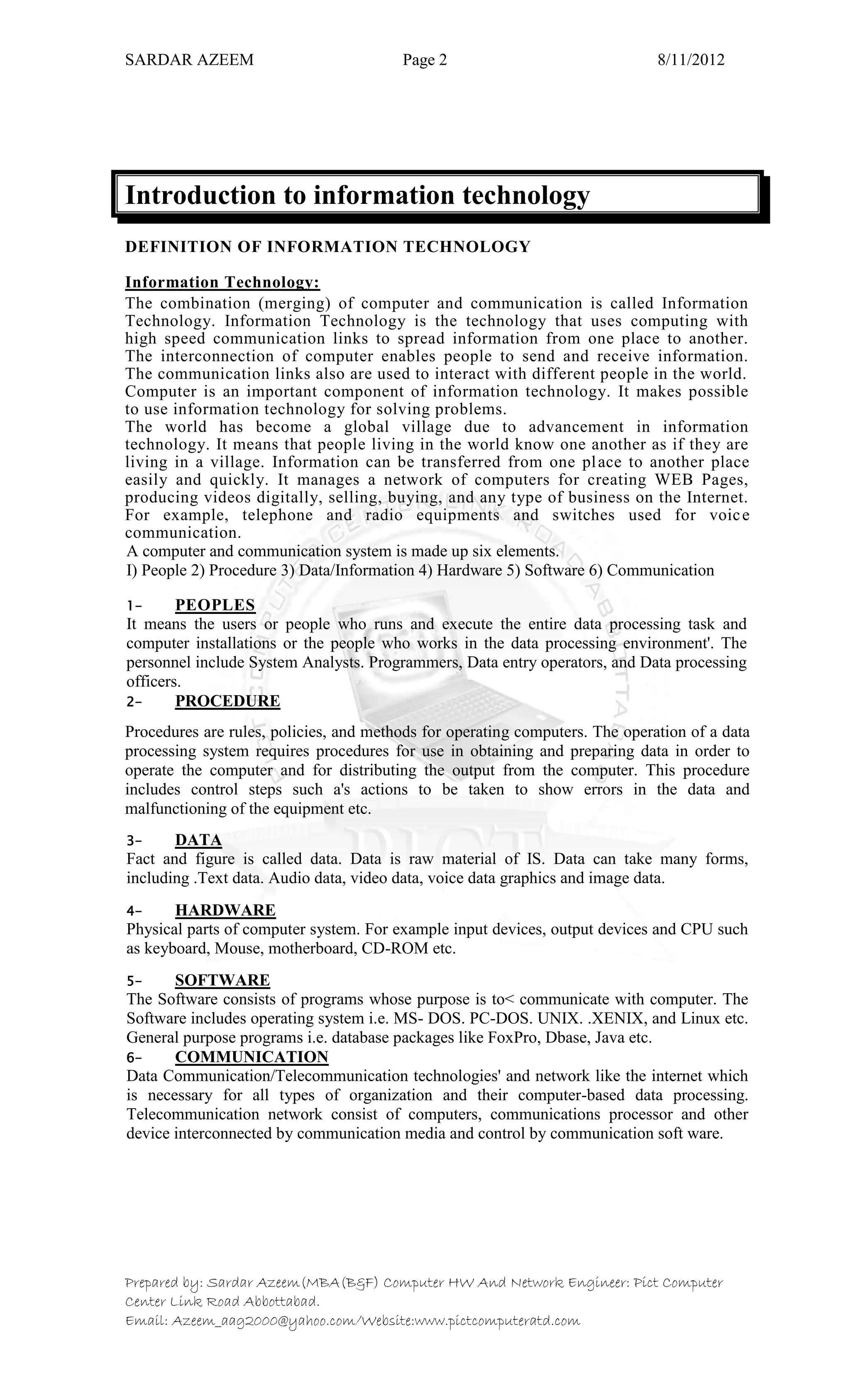
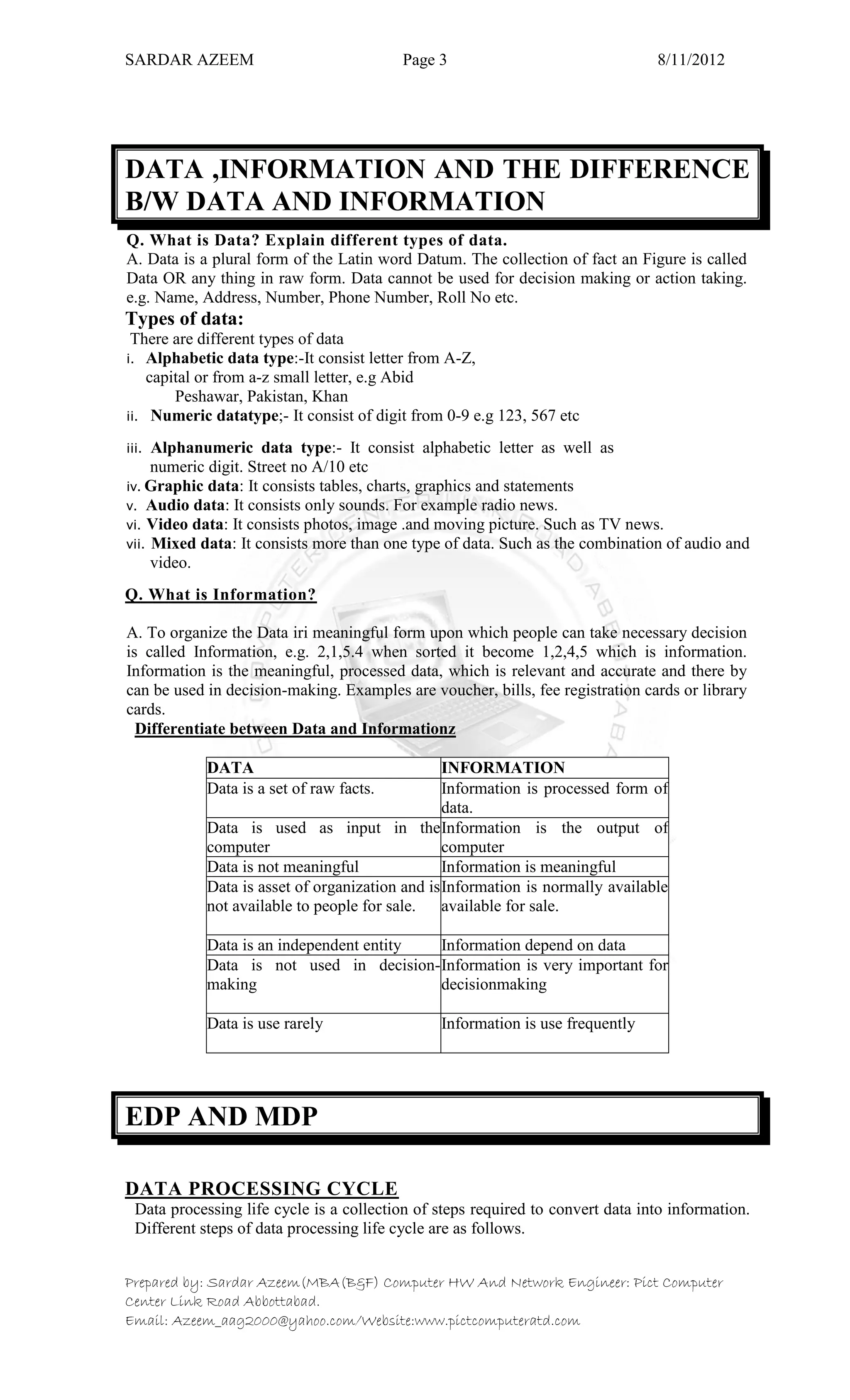
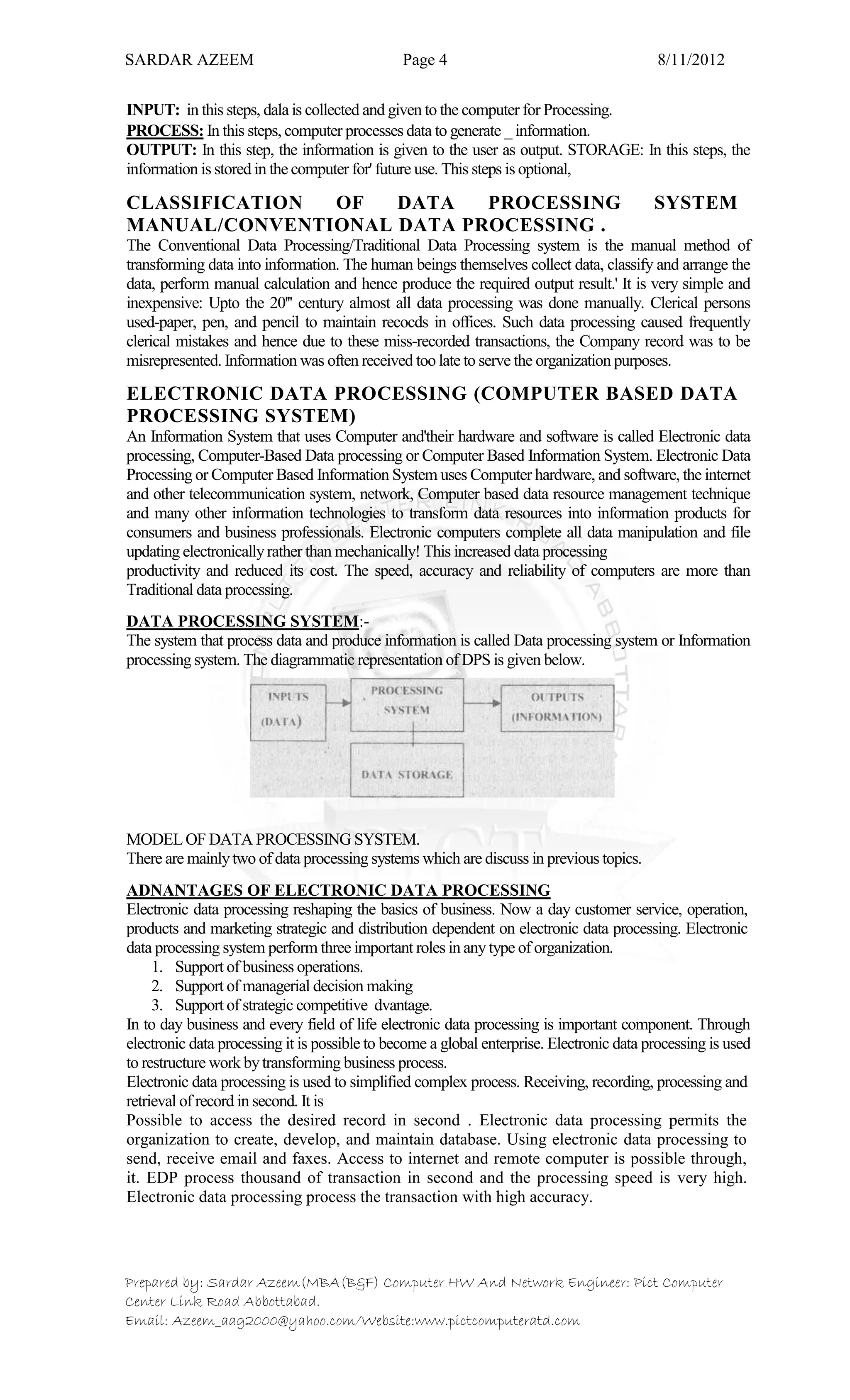
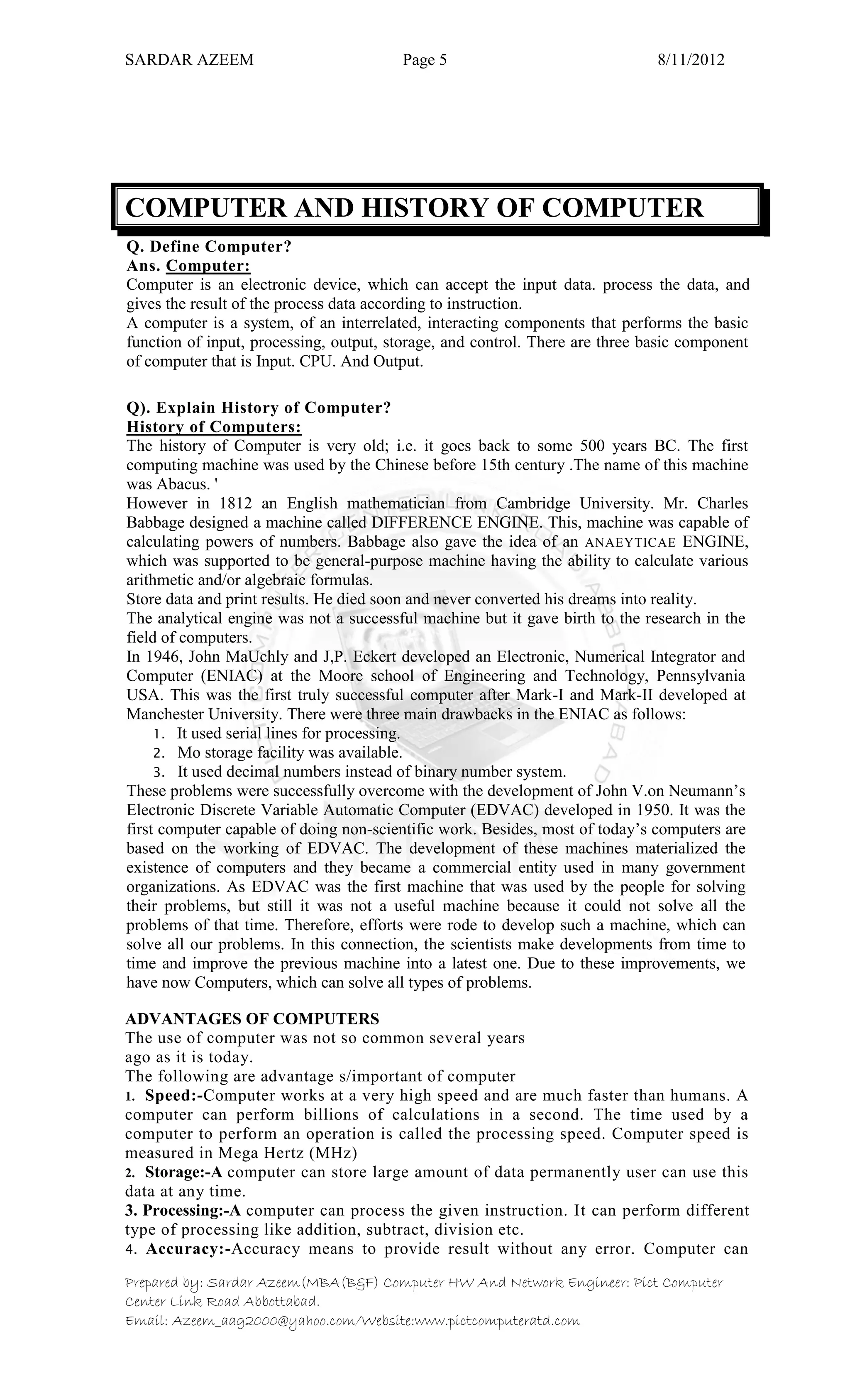

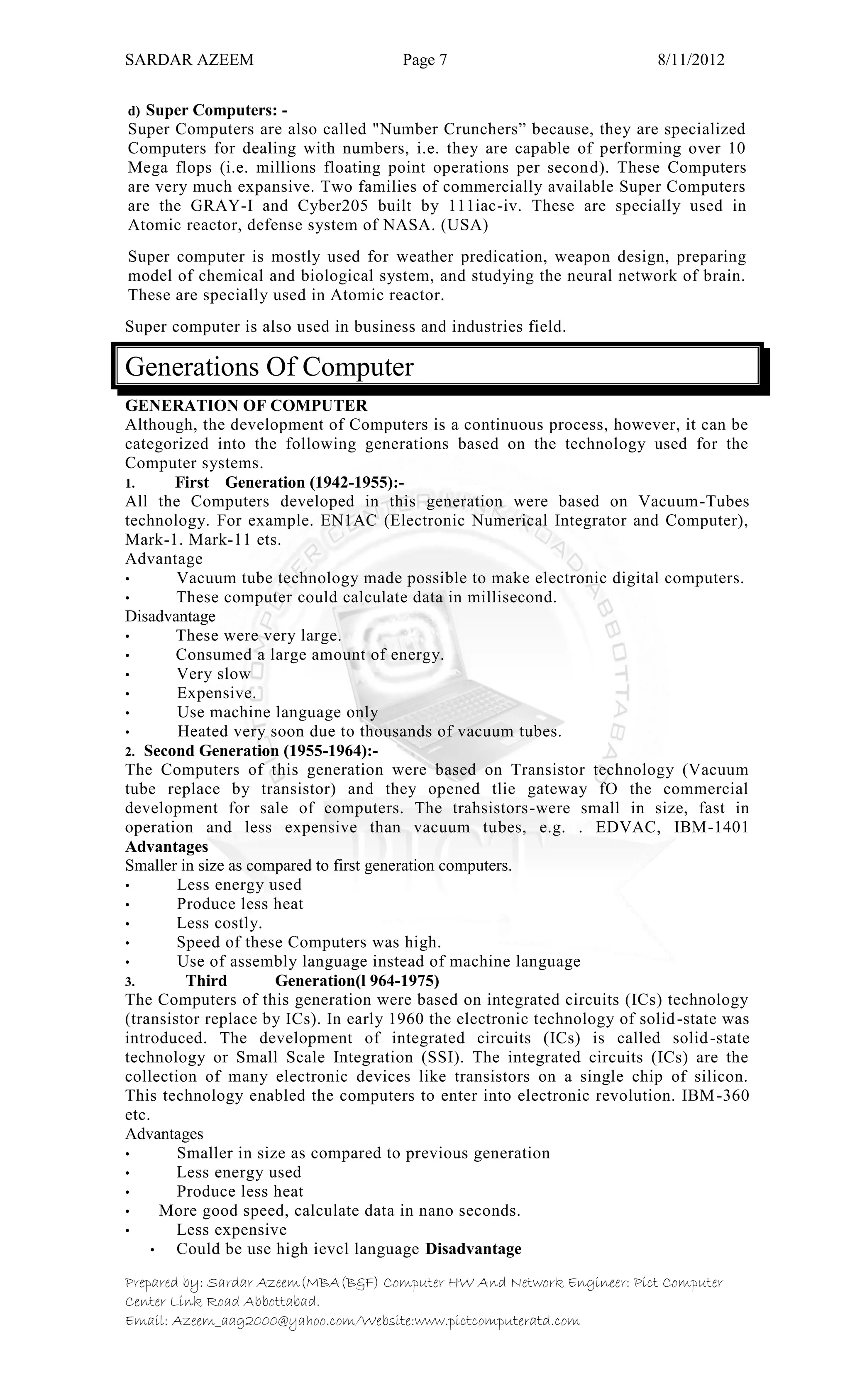
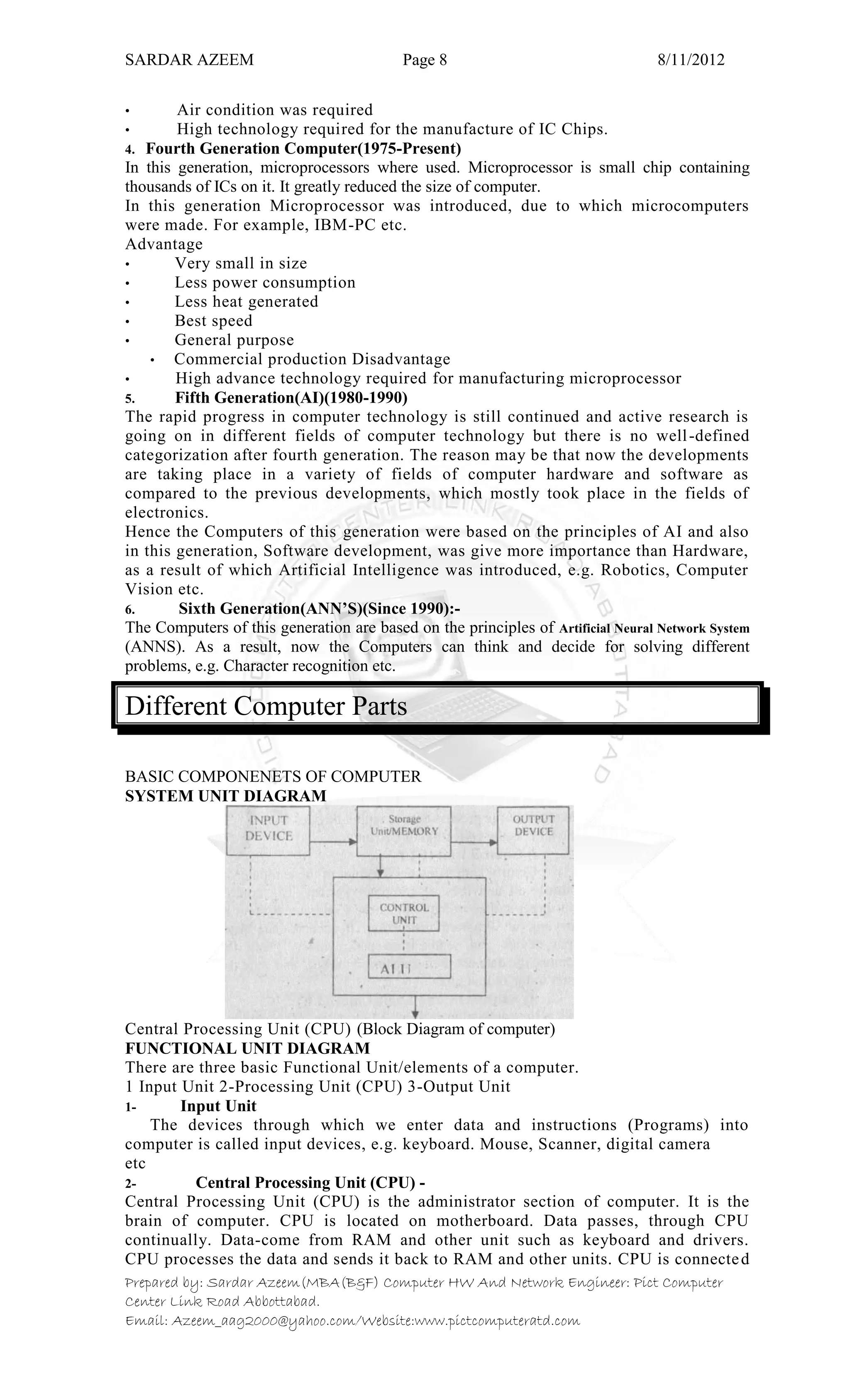

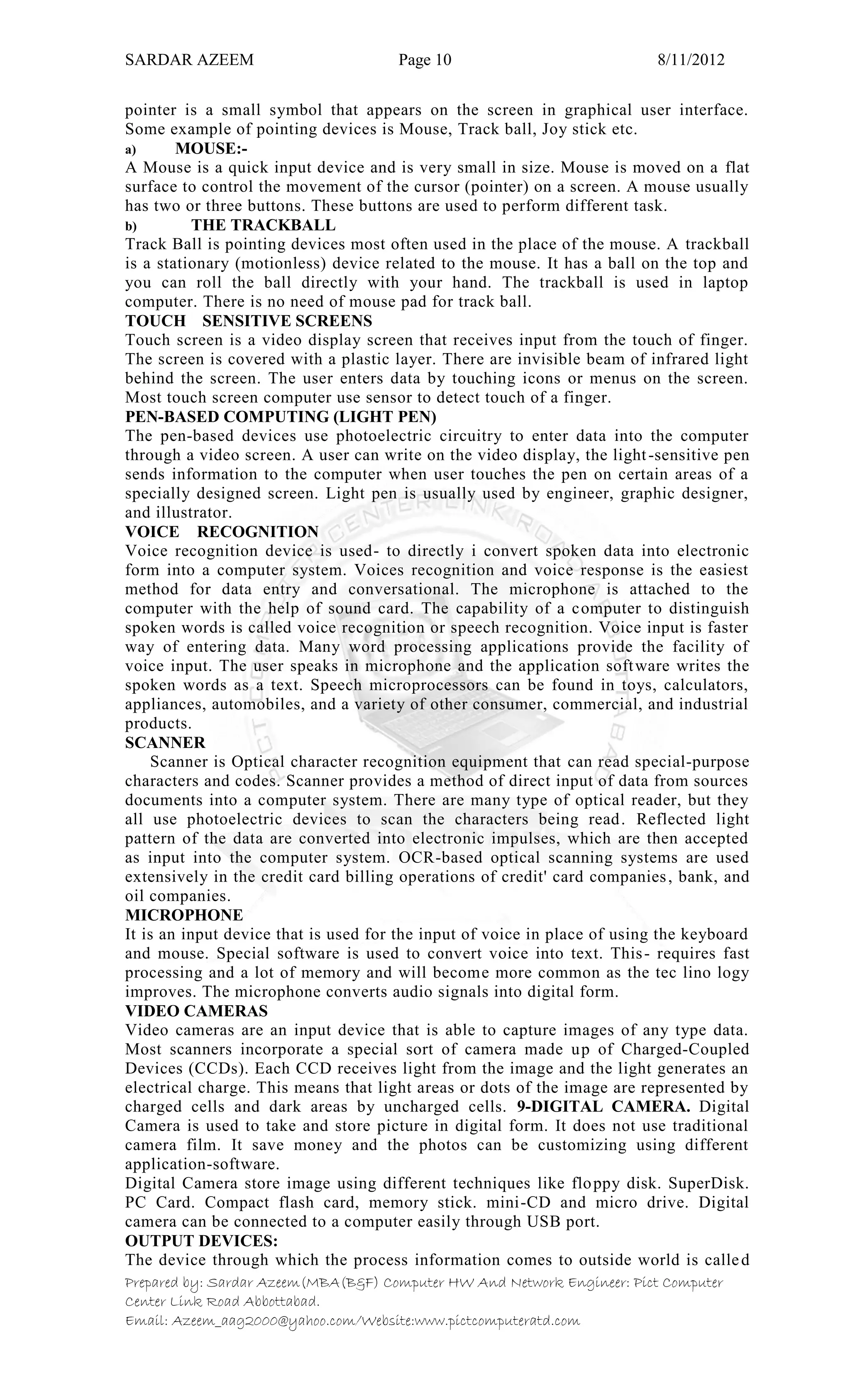
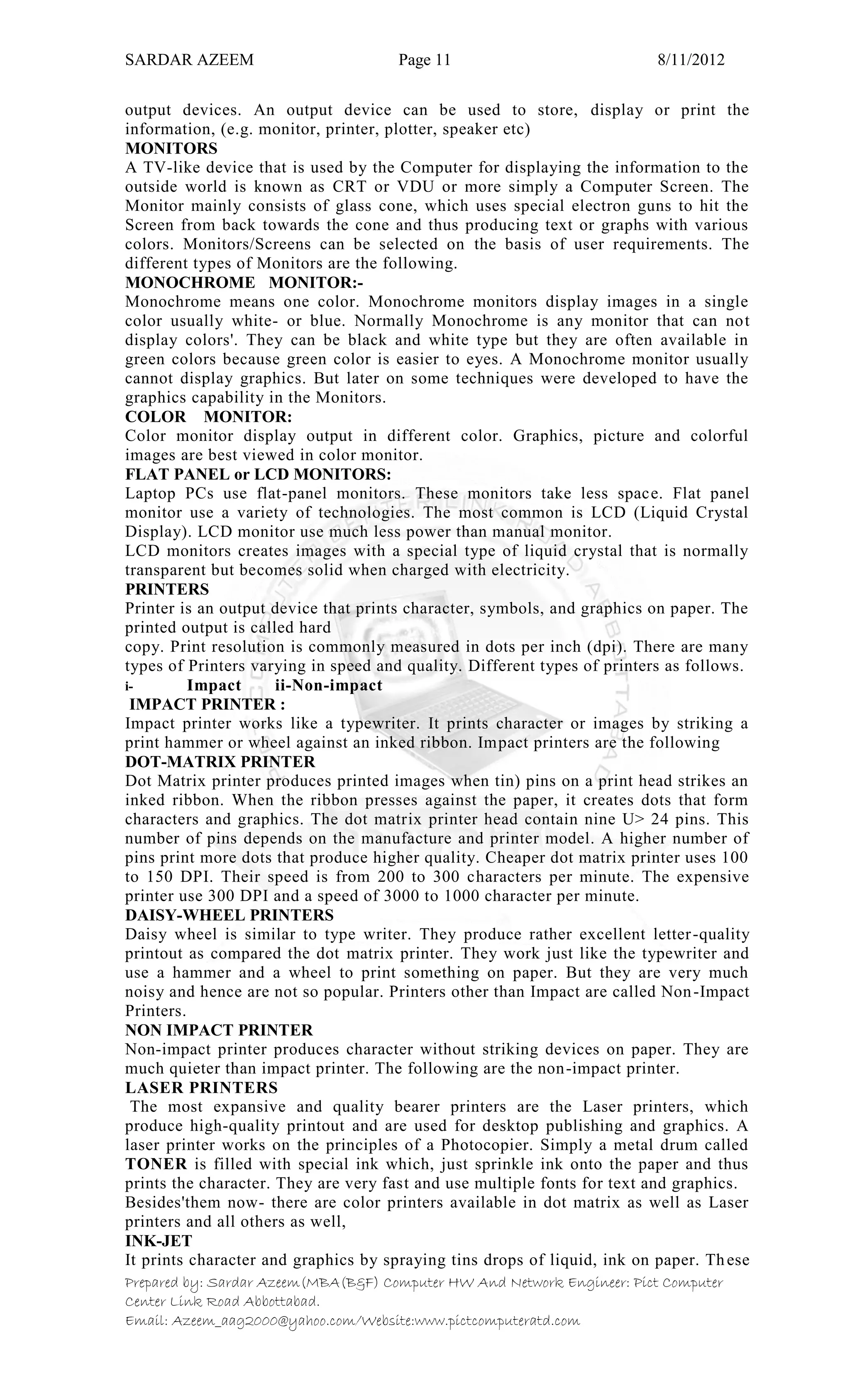
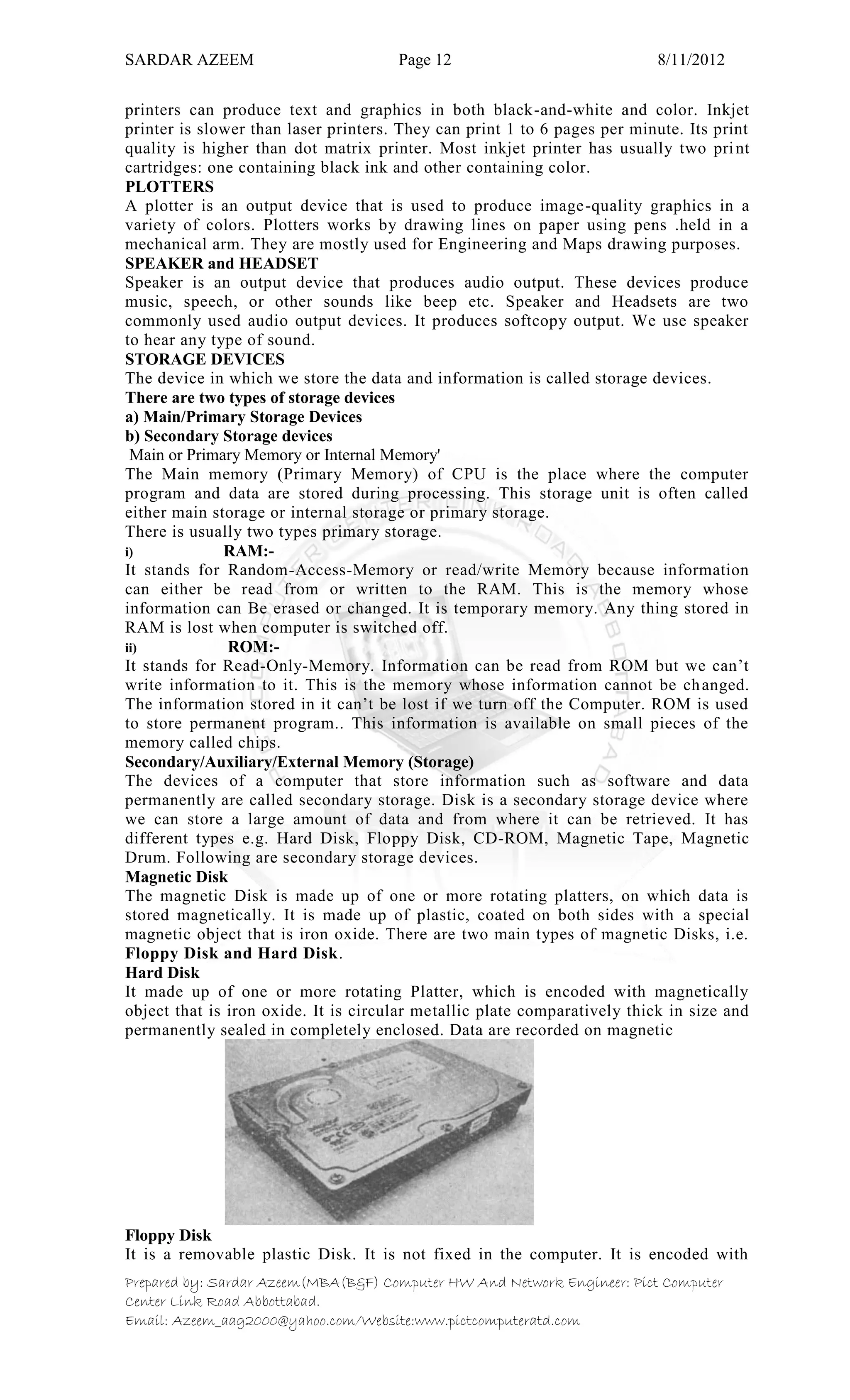
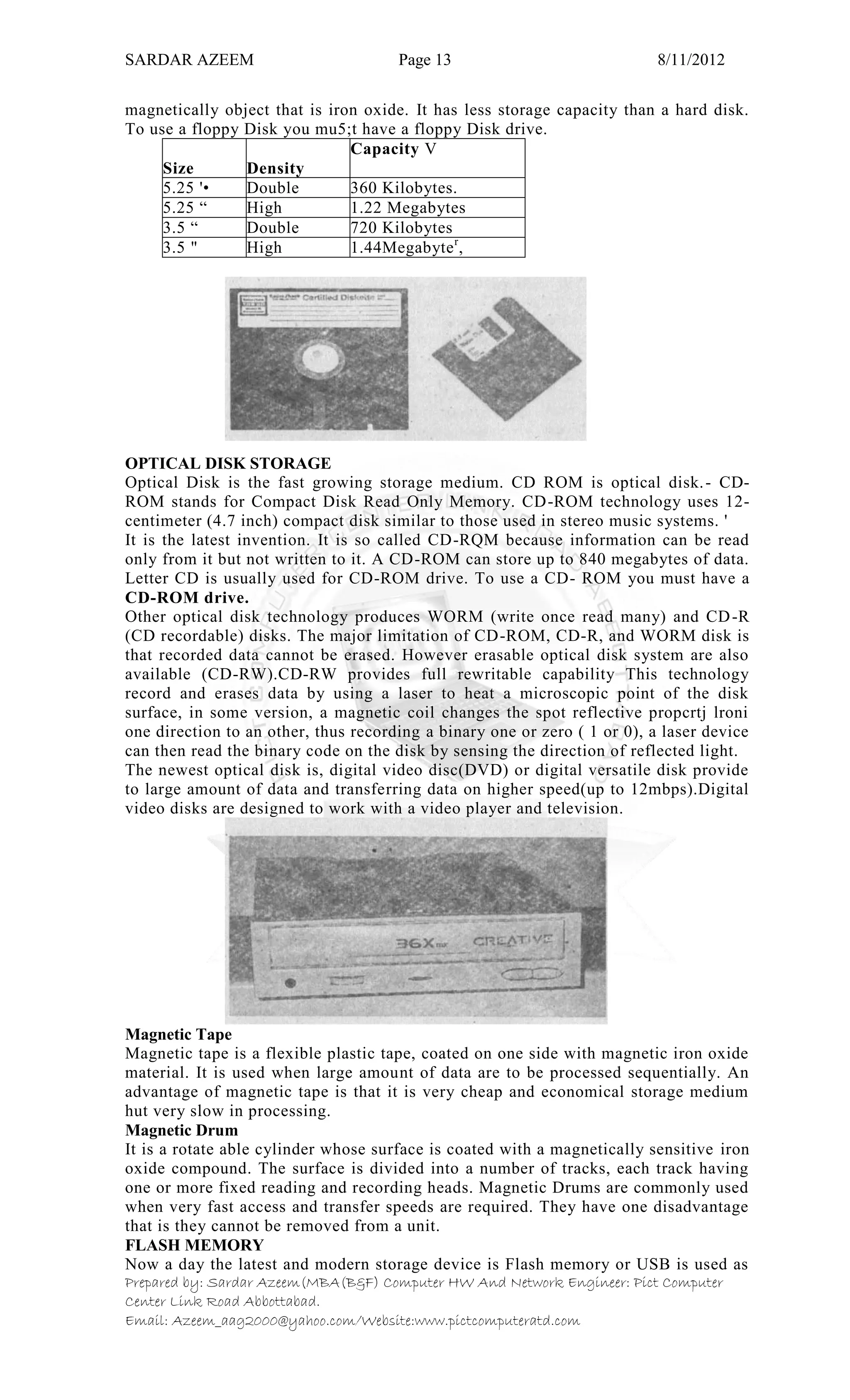
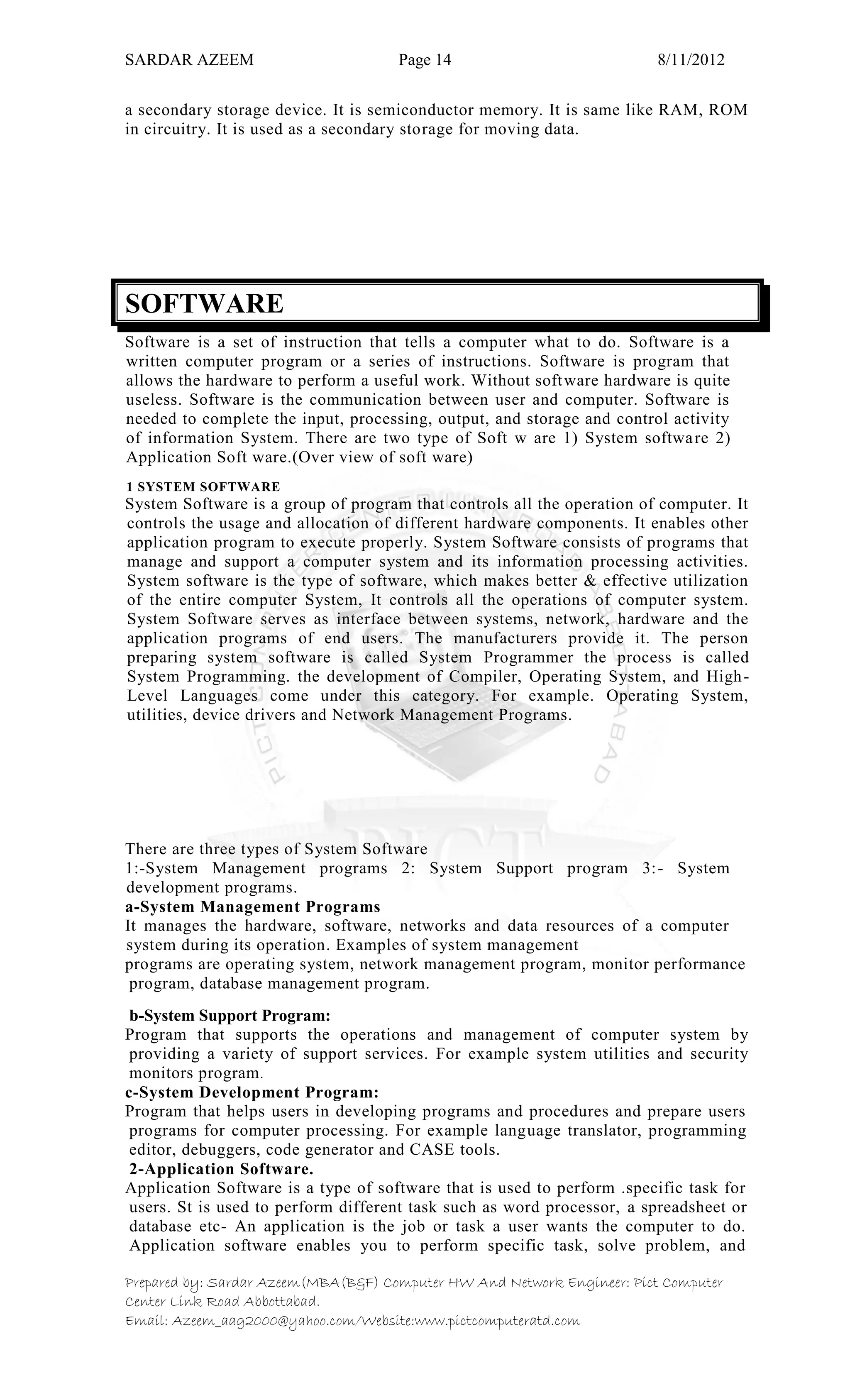
![SARDAR AZEEM Page 15 8/11/2012
Prepared by: Sardar Azeem(MBA(B&F) Computer HW And Network Engineer: Pict Computer
Center Link Road Abbottabad.
Email: Azeem_aag2000@yahoo.com/Website:www.pictcomputeratd.com
perform work.
The person preparing application software is called application programmer. For
example software developed for the PAYROLL of employees and program for
maintain of personal record come under this category.
There are two type of application Software I -General Purpose Program 2-
Application Specific Program'
1- General Purpose Program
General-Purpose application programs are programs that perform common
information processing jobs for end user. General Purpose software has enough
features to accomplish a wide variety of task. For •example, word processing
programs, spreadsheet programs, database management programs (Ms-Access,
Oracle), and graphics programs are popular with microcomputer users for home,
education, business, and scientific etc.
2-Application Specific Program/Special purpose program
Specific Application Program support specific application of end users. Specific
software performs a specific task and cannot he changed or programmed to perform
a different task.. Some major categories are Business application program are
program that are develop for important business functions or industry requirements.
For example program for accounting, marketing, finance, and employee etc.
Scientific, application programs are program that are,, develop for scientific and
engineering purpose. for example program for scientific analysis, engineering
design, and monitor of experiment.
Other application programs are other than business and scientific. For example
computer application in education, entertainment, music, art. law.-and medicine,
video-game program, entertainment program, etc.
PROGRAM TOOLS:
Following are the programming tools for the programmer with the help of Which
the programmer can write a perfect program. These are
I - Algorithm 2- Flow Chart
ALGORITHM
An algorithm is a finite set of instructions, which accomplishes a particular task.
An algorithm is a finite step-by-step list of well-defined instructions for solving a
particular problem.
ALGORITHM NOTATION
The algorithm is a base of not only effective data structure but it is also the base of
good programming. Therefore, it is necessary' that each algorithm should be written
clearly. A complete algorithmic notation is given below.
3. Name of algorithm:
Every algorithm is given a-name, written in capital letters.
Introductory Comments.
The algorithm name is followed by a brief description of the tasks the algorithm
performs. This description gives the name and types of variables used in the
algorithm.
Steps:
The algorithm is made of a sequence of numbered steps. Each beginning with a
phrase enclosed in square brackets which gives an abbreviated, description of that
step. Following this phrase is an ordered sequence of statements which describe the
actions to be executed, or tasks to be performed.
Comments:
An algorithm step .may terminates with a comment enclosed in round parenthesis,
which is used to help the reader better understand that step. Comments specify no
action and arc enclosed only for clarity.
Example of algorithm:
Algorithm C‘RADES( V!1,M2, M3.M4.Average) .
This algorithm reads tour marks denoted by Ml. M2, M3, M.4 and compute the
average grade, Al! Variables‘ are assumed to be real]
(1) [Input individual marks]
Read (MLM2.M3, M4)](https://image.slidesharecdn.com/ict-200824051213/75/Ict-15-2048.jpg)
![SARDAR AZEEM Page 16 8/11/2012
Prepared by: Sardar Azeem(MBA(B&F) Computer HW And Network Engineer: Pict Computer
Center Link Road Abbottabad.
Email: Azeem_aag2000@yahoo.com/Website:www.pictcomputeratd.com
4. [Compute average grade]
.Averages (M l-+'M2+M3+M4)/4
5. [ Output Result )
Write ("Final grade is" , average)
(4) (Finish] '
Exit
FLOWCHART
Charting:
Charting is a graphical or pictorial means of presenting data. Charting takes the flow
of work and makes a picture of it. Charts can be used to illustrate statistical' data,
locations of desks or equipment, relationships between people and jobs, sequences.
Of events, work flow; organizational structure and planning or implementation
schedules.
T he primary use of charting is for communication and documentation of the system.
Charting is also used during feasibility studies, problems definition understanding
the existing system, defining new systems requirements,. Design, cost comparisons,
final report, and implementation.
For example Flow chart. Bubble chart or data flow diagram, Grind' chart etc.
Flow charts
A flowchart is a. pictorial/graphical presentation of flow of data to solving the
problem. A flowchart is a diagrammatic representation of
the logic or sequence of steps that solve a problem. Flowchart is tools for the
programmer to analyze, organize, and solve a problem. A number of pictorial
figures are used to help draw the flow charts... Finally the instructions are coded in
one of the programming languages, called a program. The person who writes
program are called, programmer.
When developing a flow chart the systems analyst (or programmer) should observe
the following guidelines:
Flow charts are drawn from the top of a page to the bottom and from left to right.
The activity being flow-charted should be. Carefully defined and this definition
made, clear to the reader. Where the activity starts and where it end should be
determined.
Each step of the activity should be describes one-verb descriptions, e.g. prepare
statement or file customer statement.
Each step of the activity should keep in its proper sequence.
The scope or range of the activity being flowcharted should be carefully observed.
Any branches that leave the activity being charted should not be drawn on that flow
chart. A connection symbol should be used and that branched put on separate pages
or omitted entirely if it does not pertain to the system.
Use the standard flow-charting symbols.
Type of flowcharts:
The most important types of flowcharts are:
System flowchart. Program flowchart System Flowchart
A system how chart show the overall work flow of the system. It is a pictorial
description of the sequence of the combined procedures that makes up the system. A
system flowchart shows the sequence of physical devices used to solve that problem.
Input/ output symbol
Processing symbol
Flow lines
Off page connector
Documents (hard copy) Display symbol
Manual input symbol online storage symbol](https://image.slidesharecdn.com/ict-200824051213/75/Ict-16-2048.jpg)
